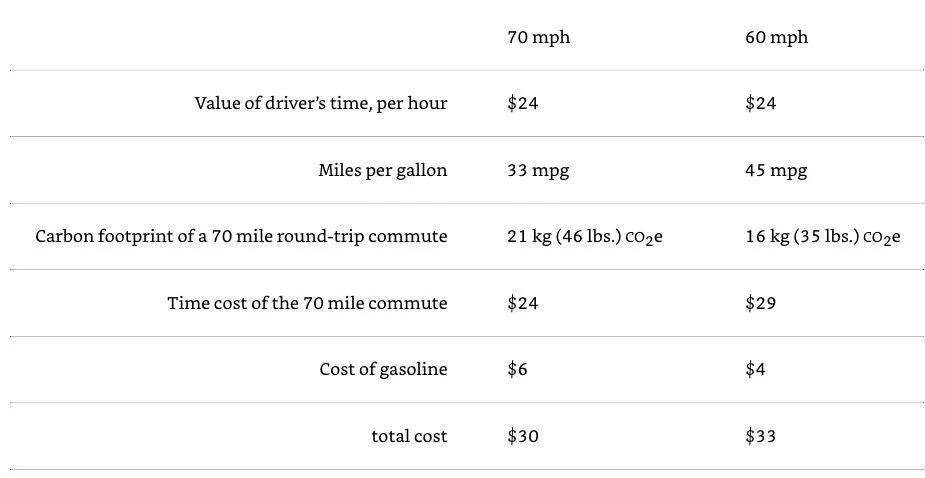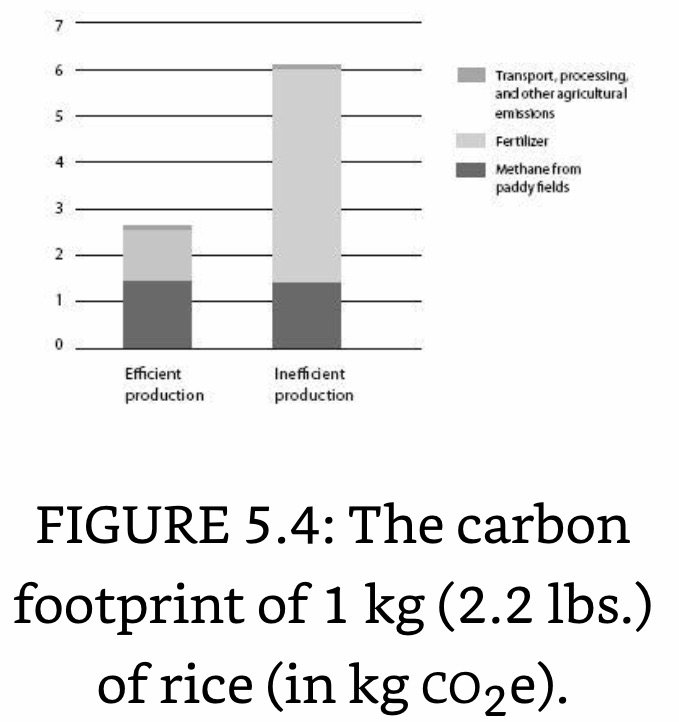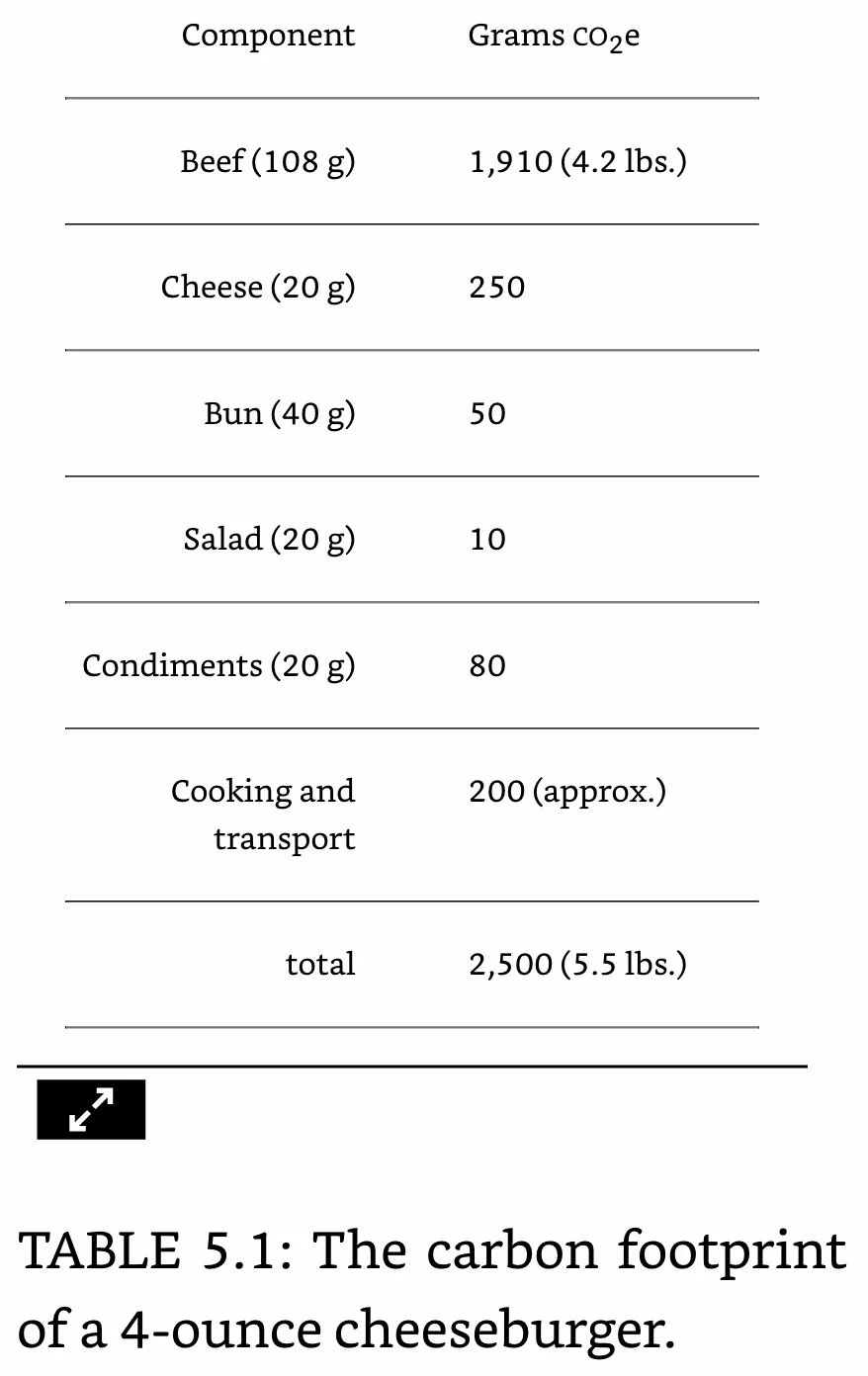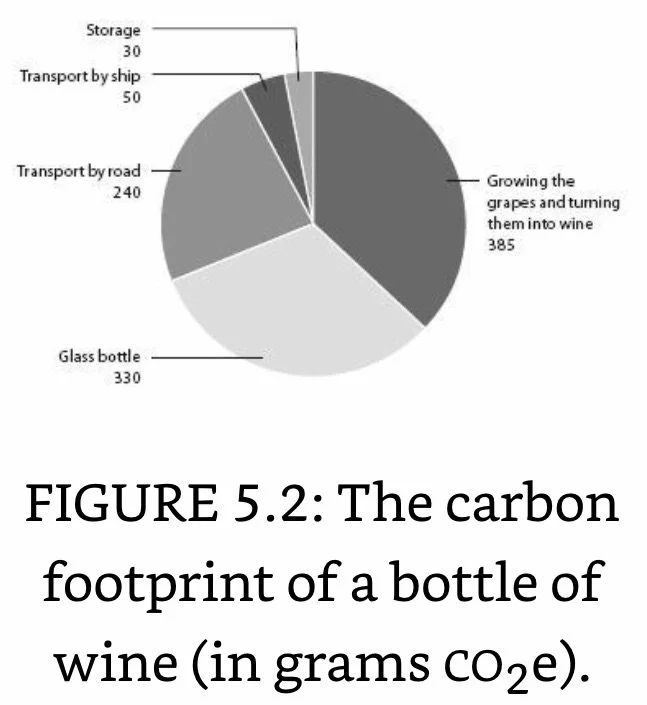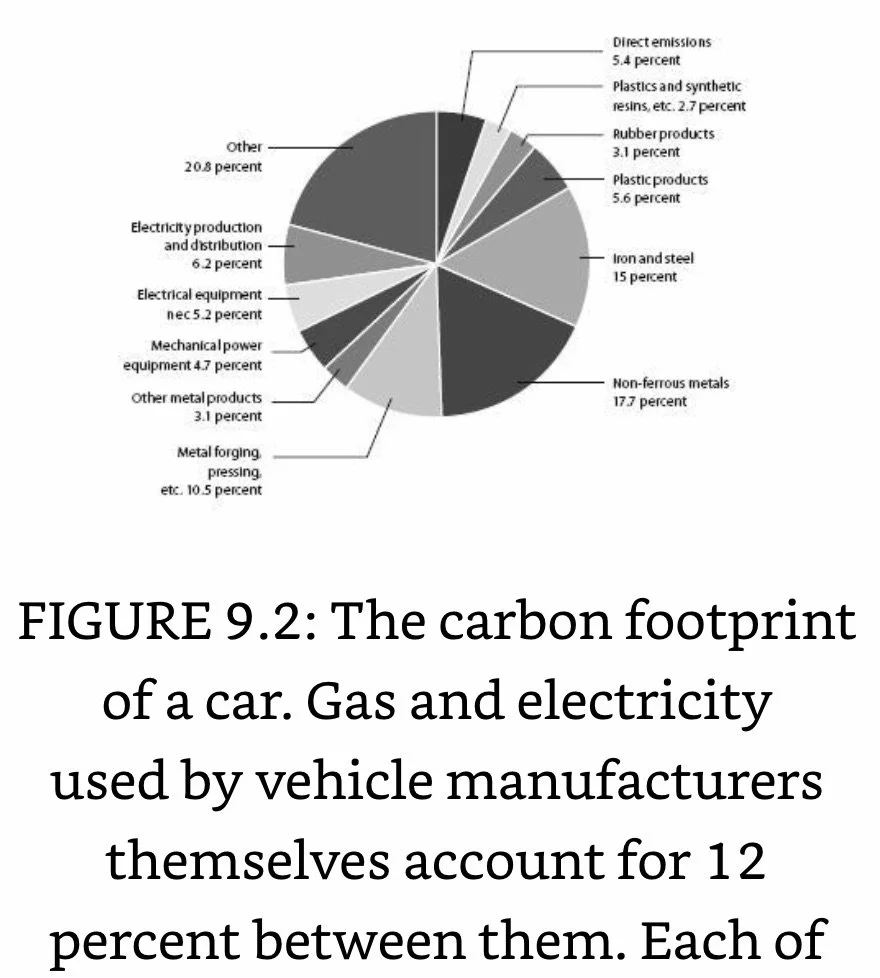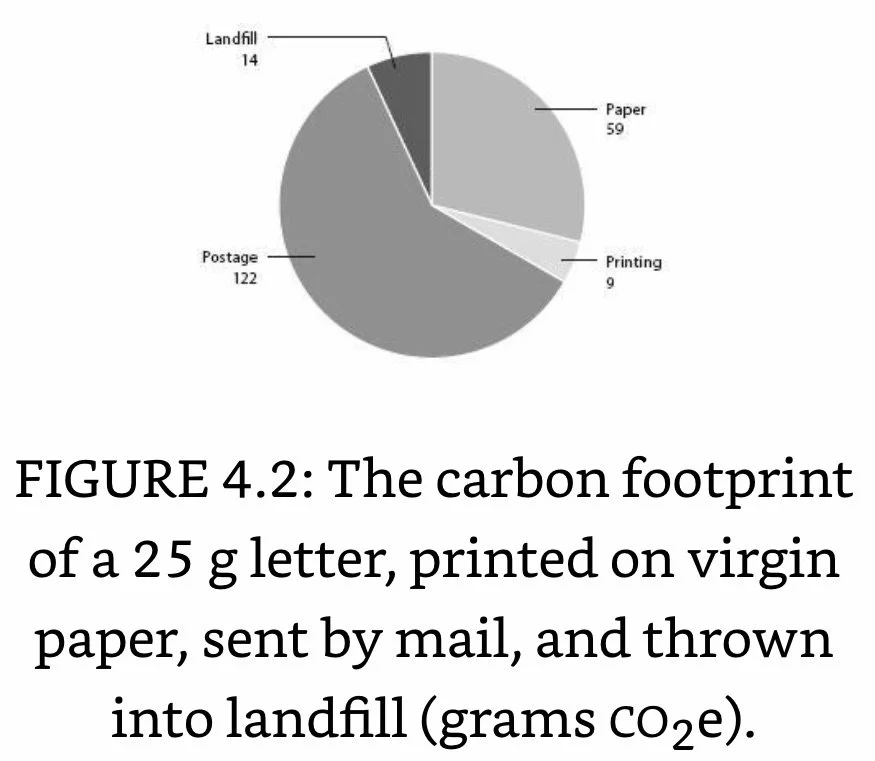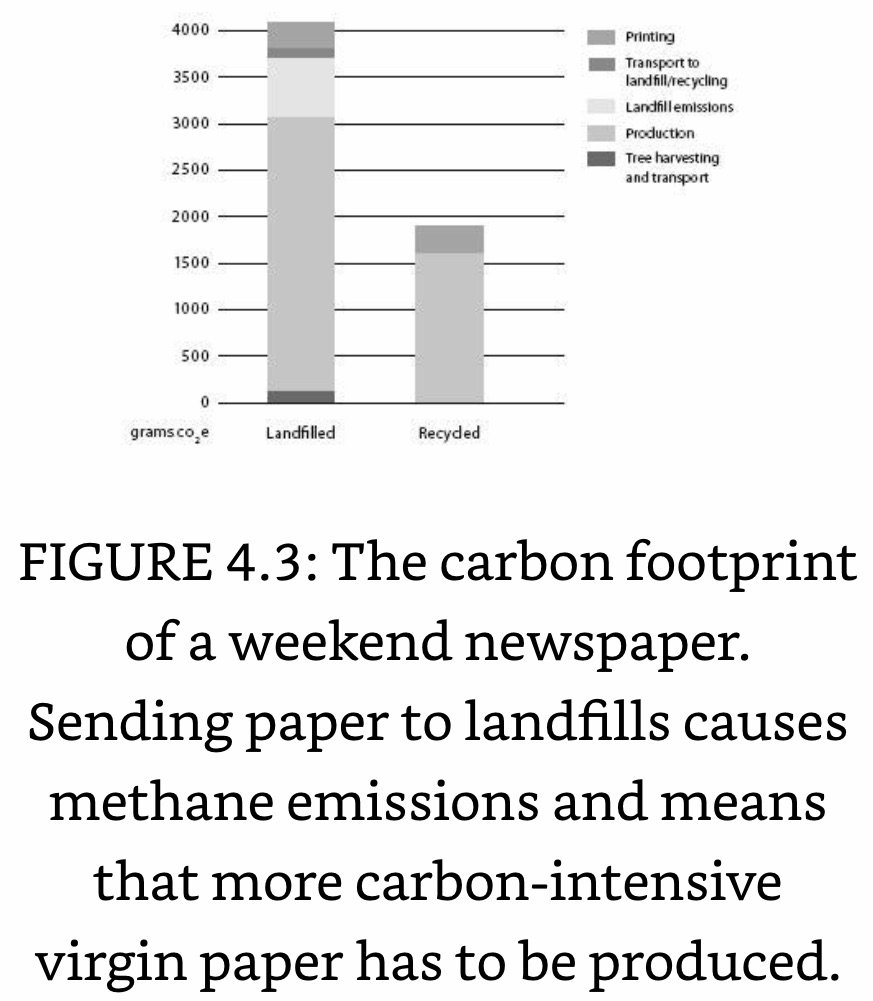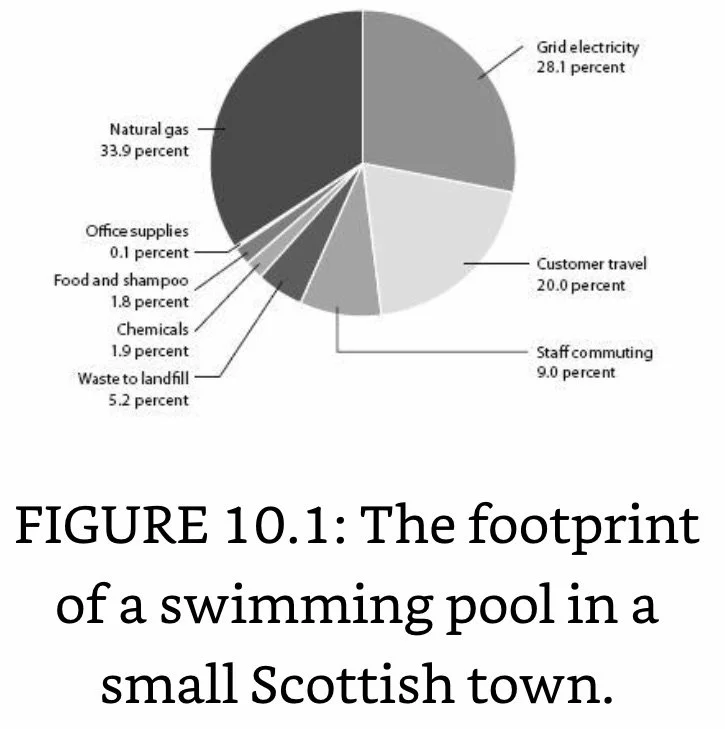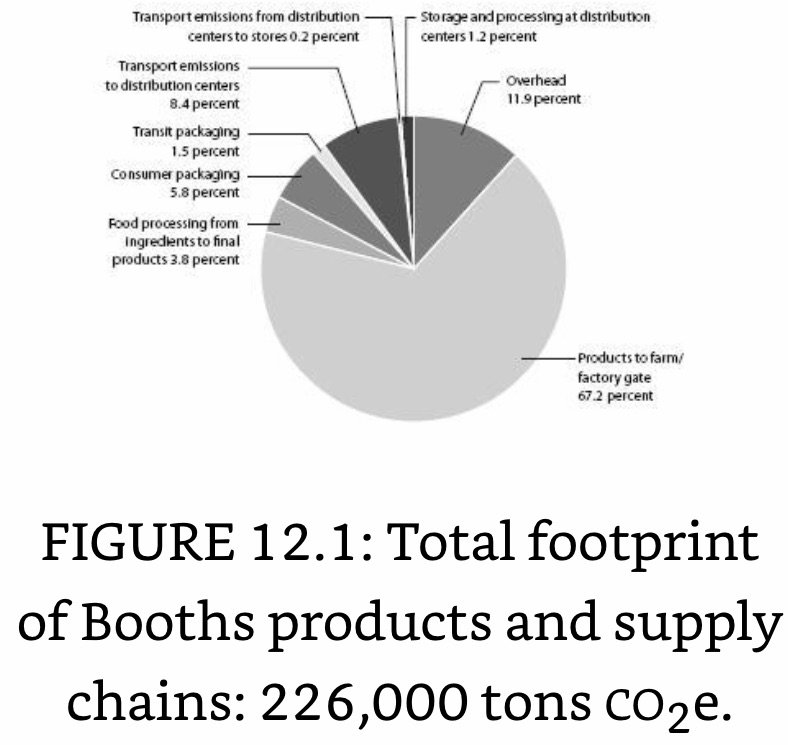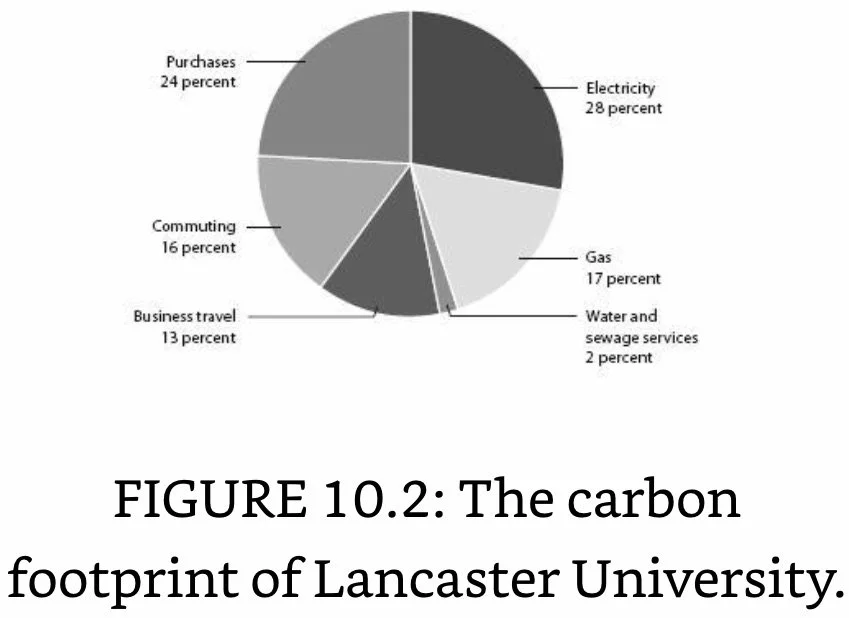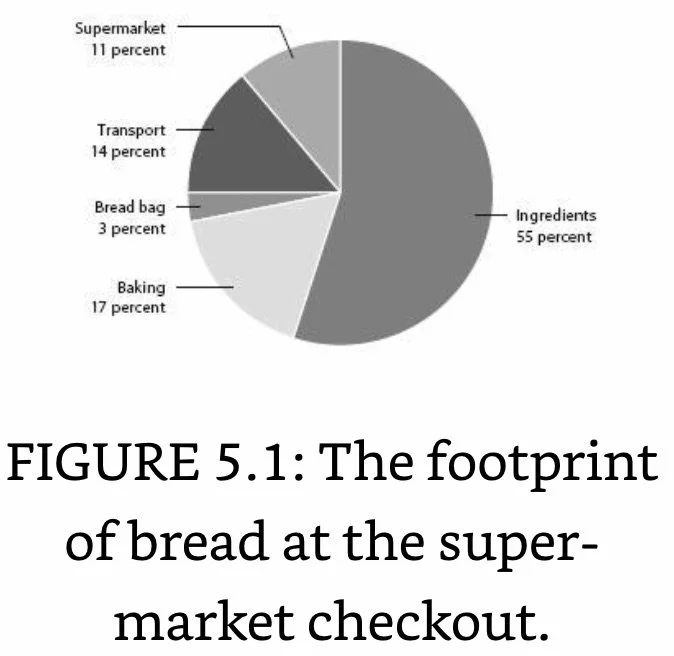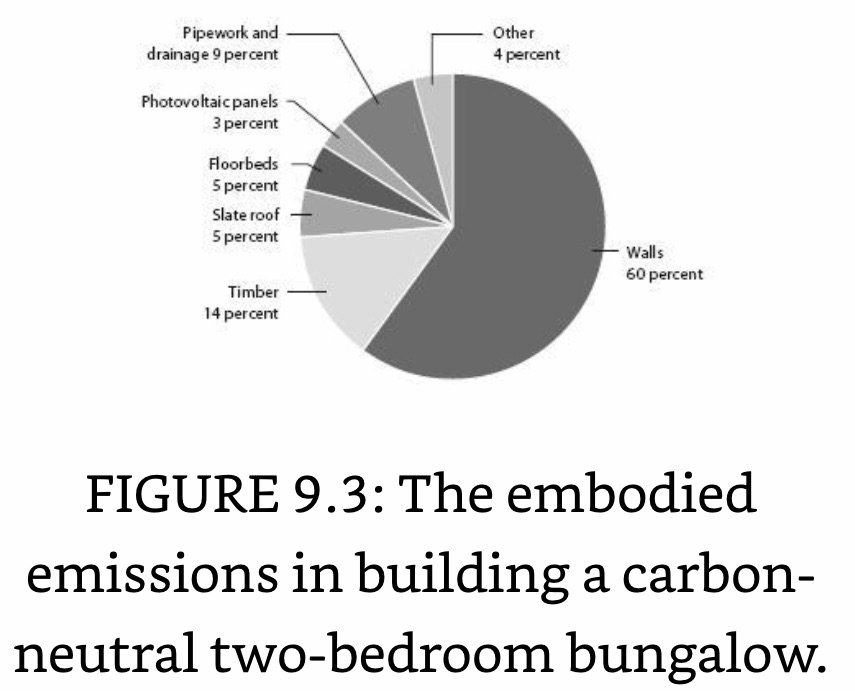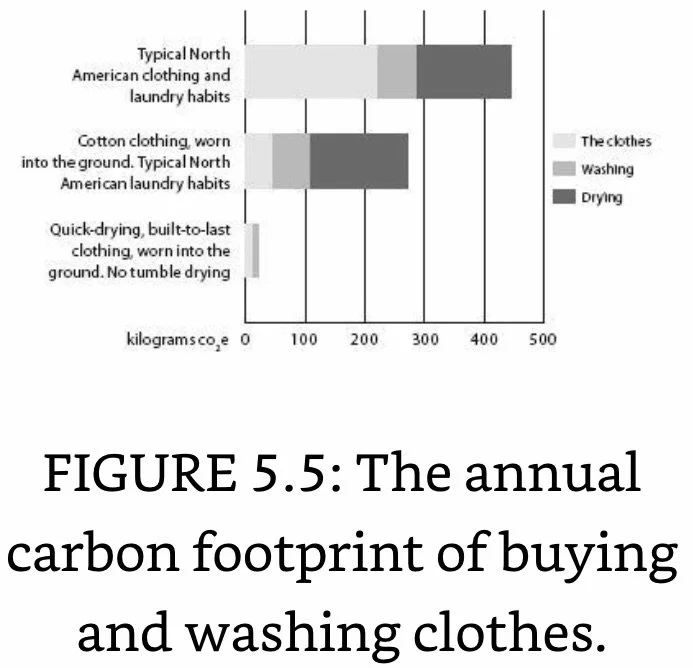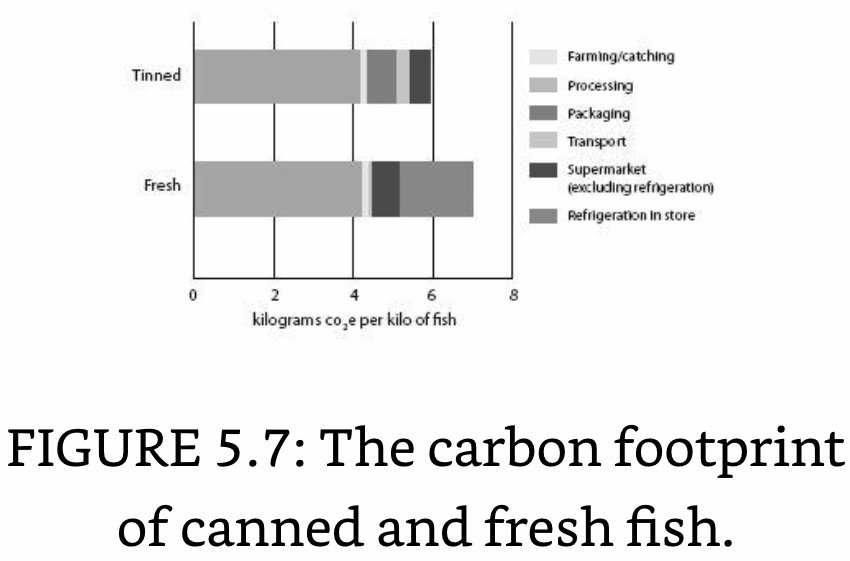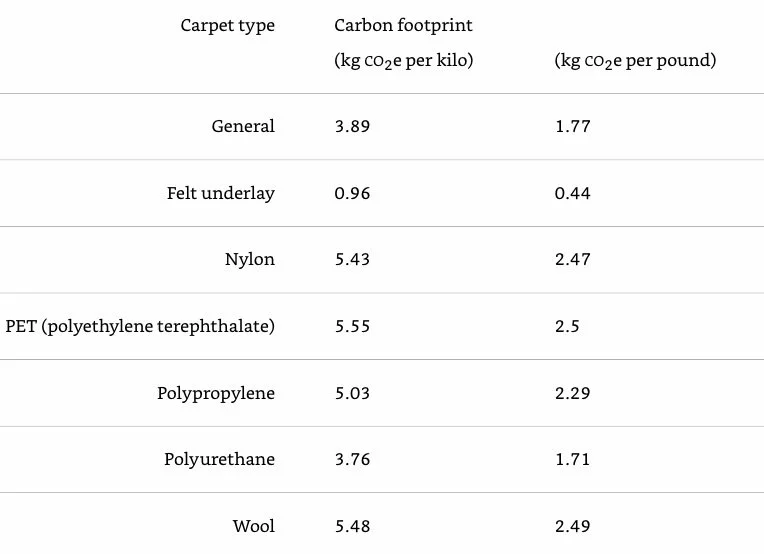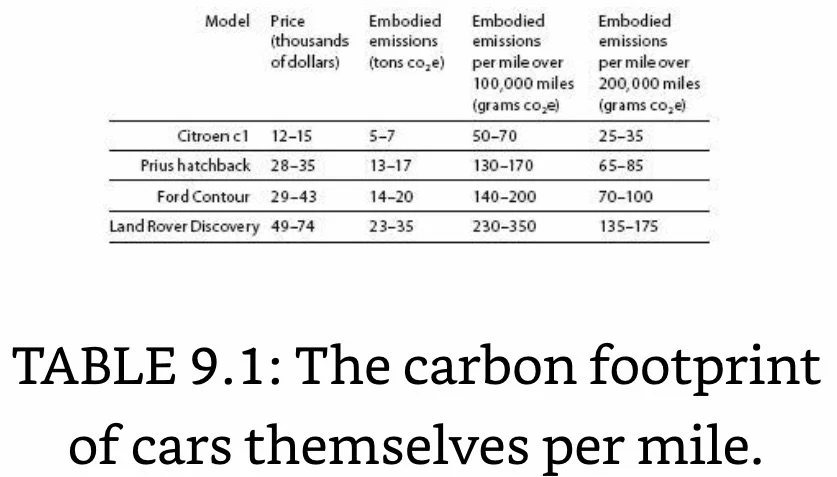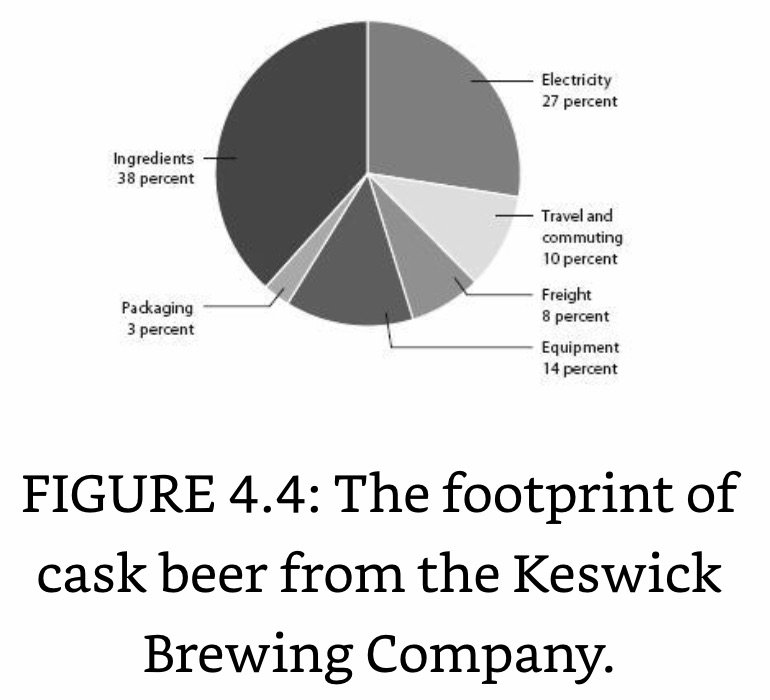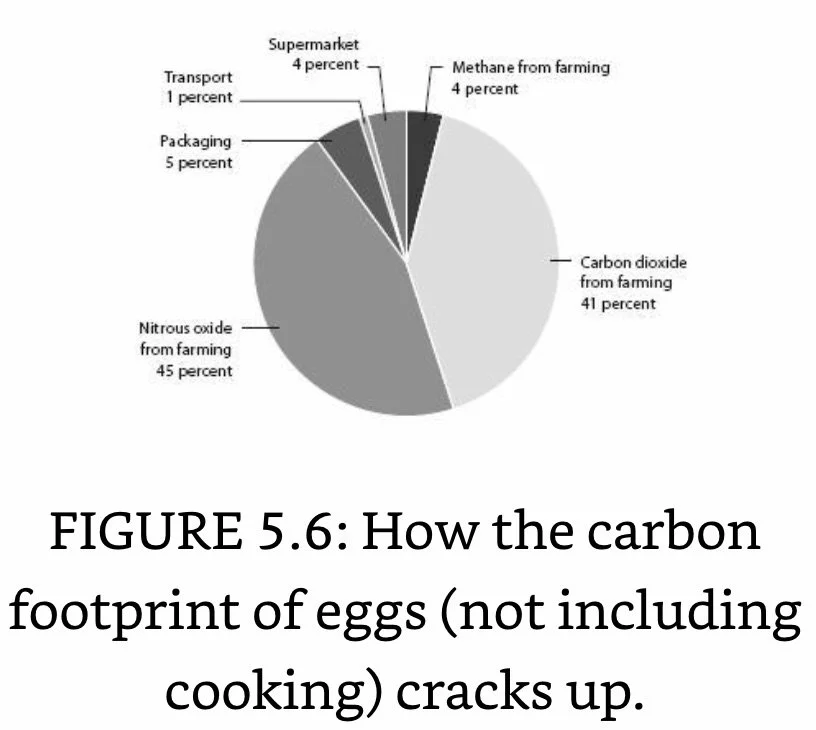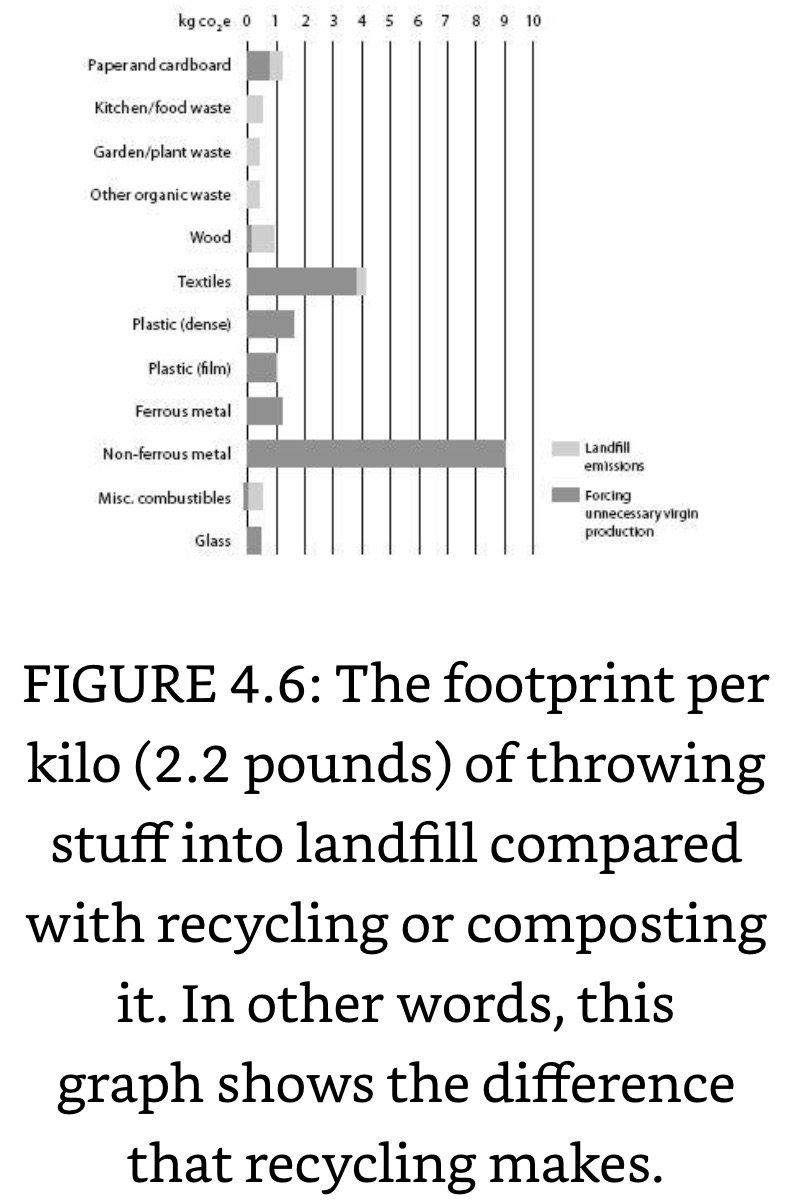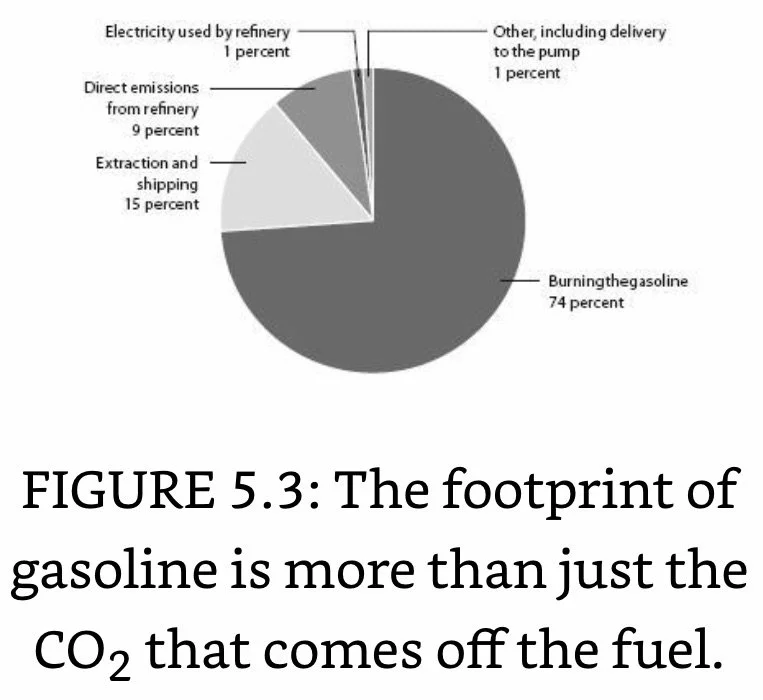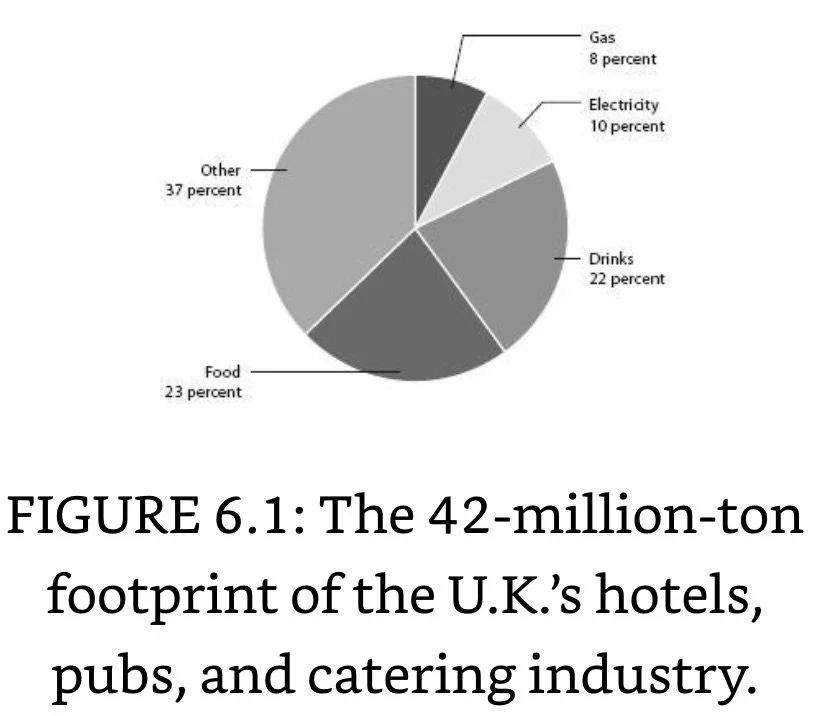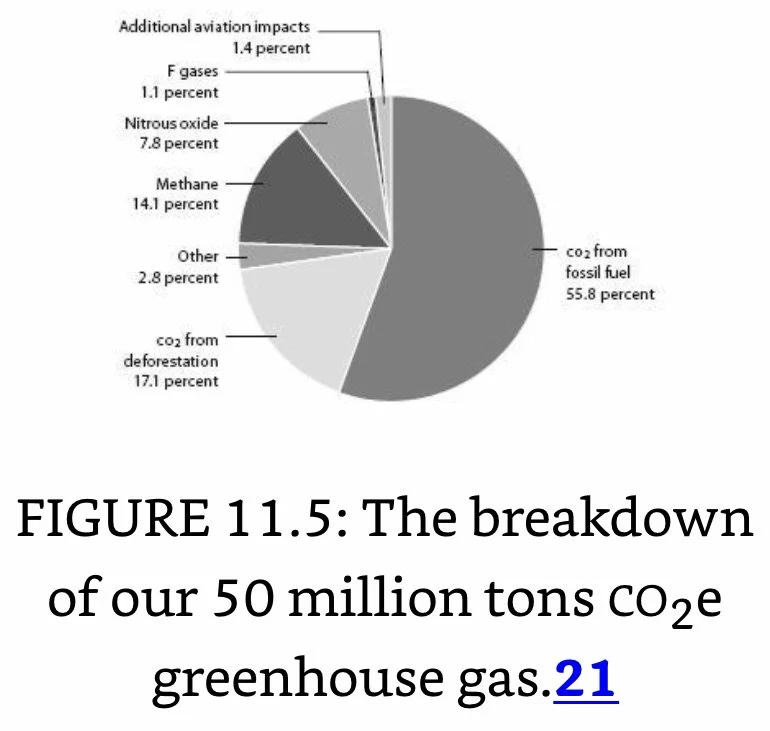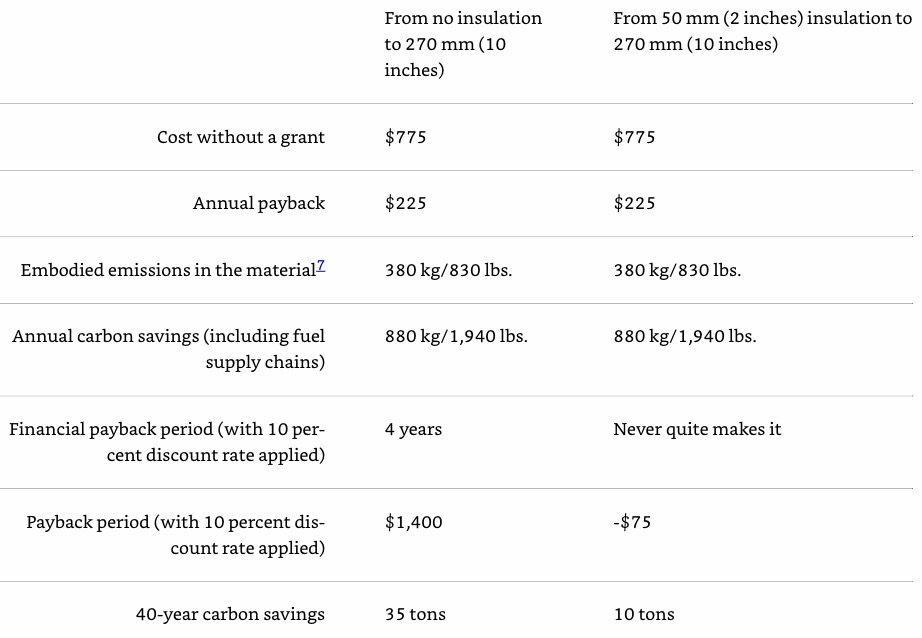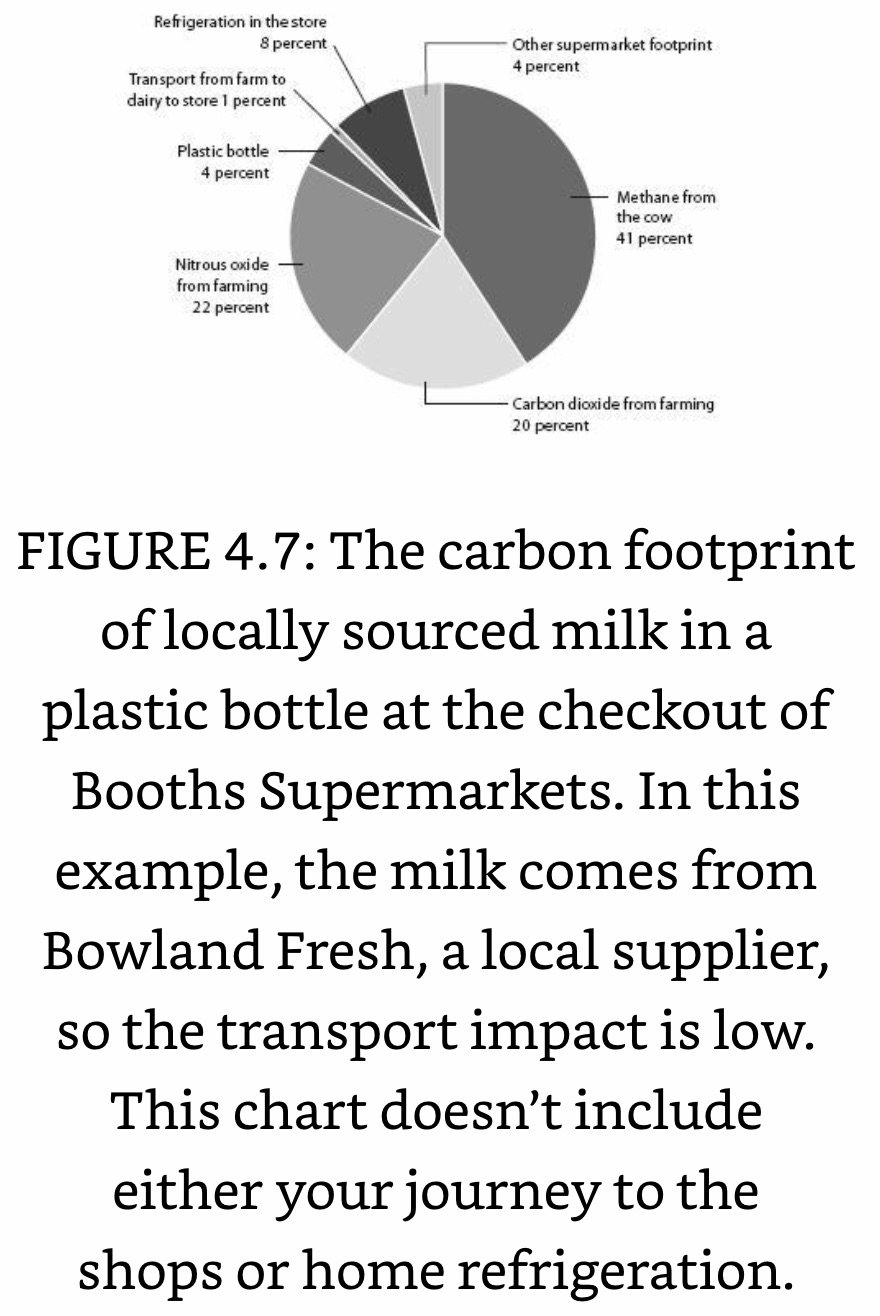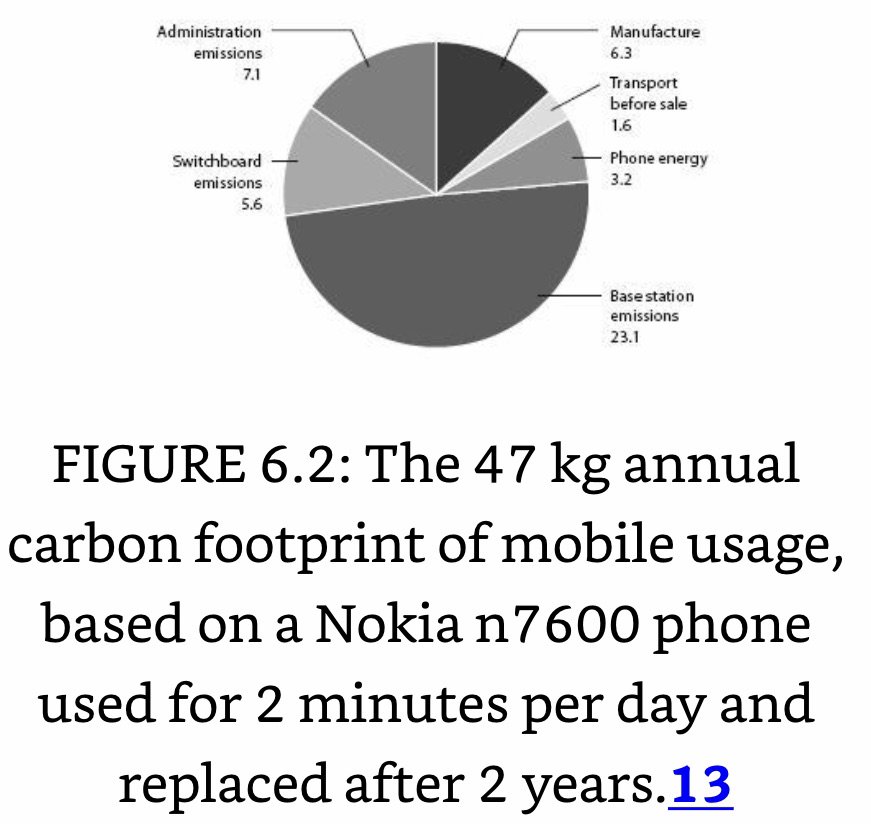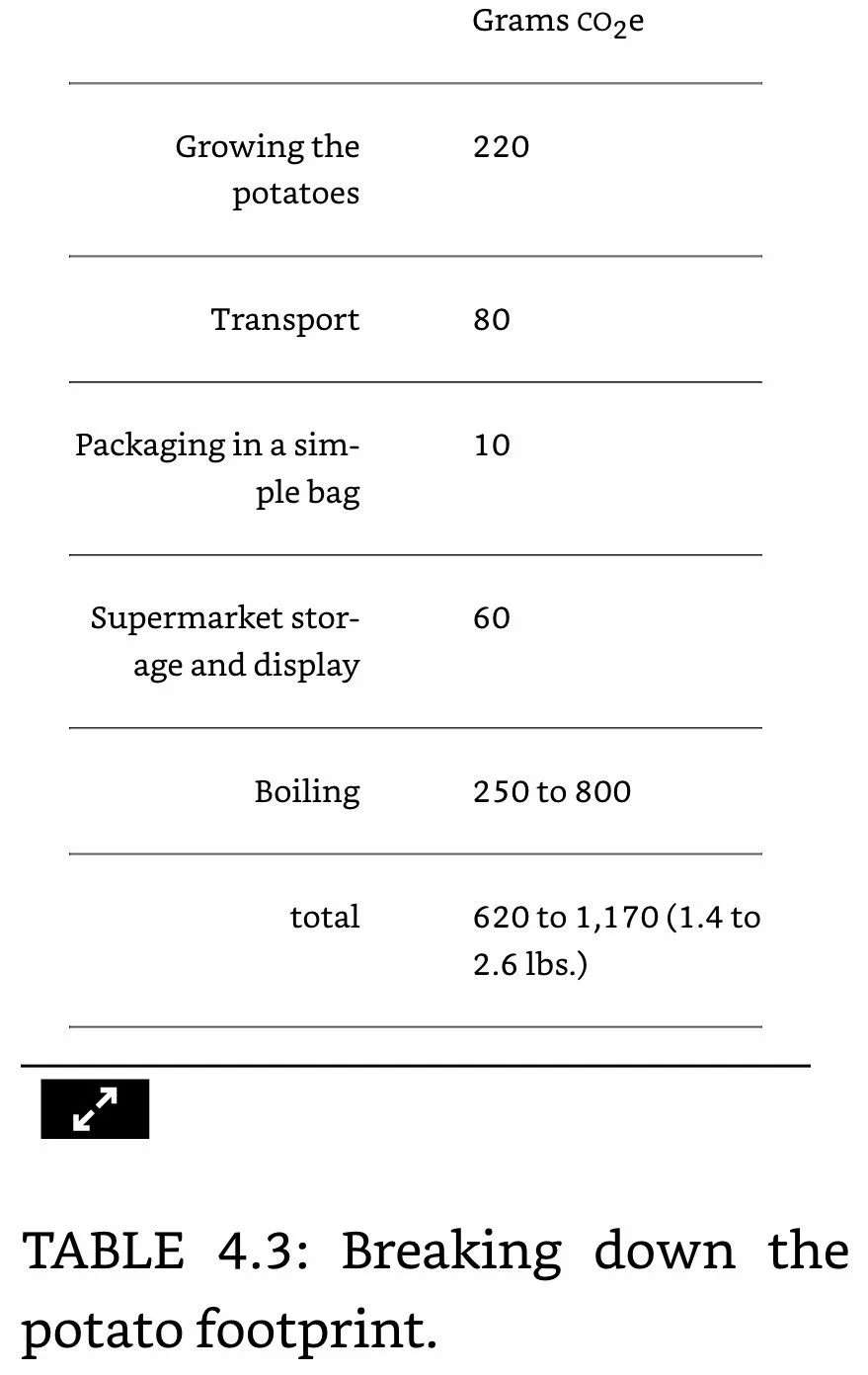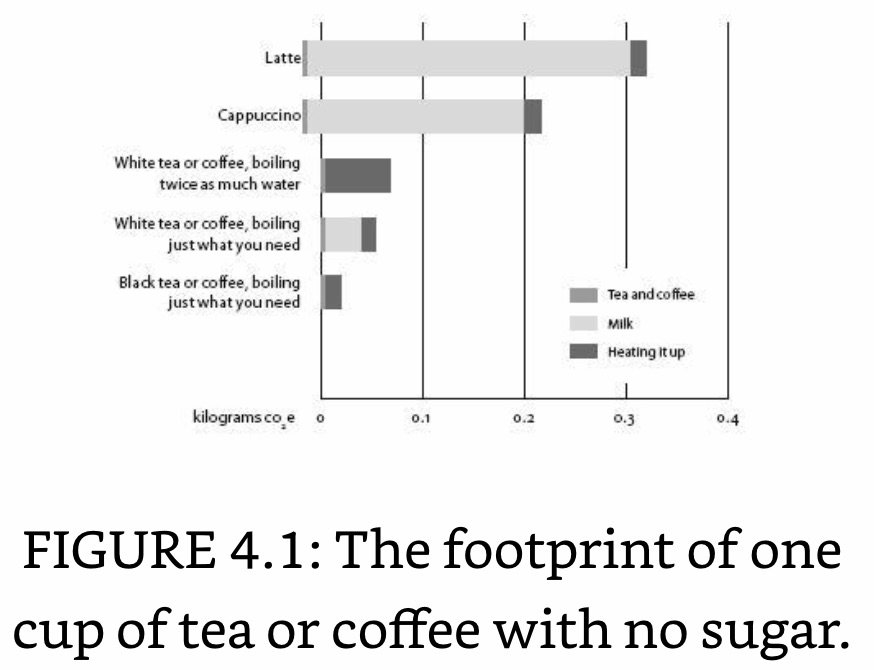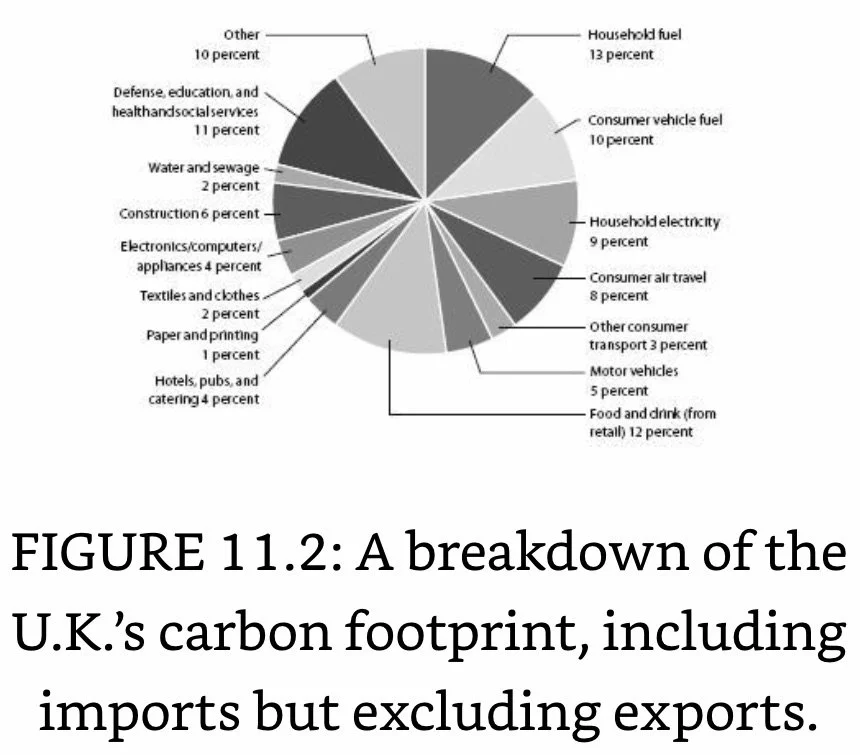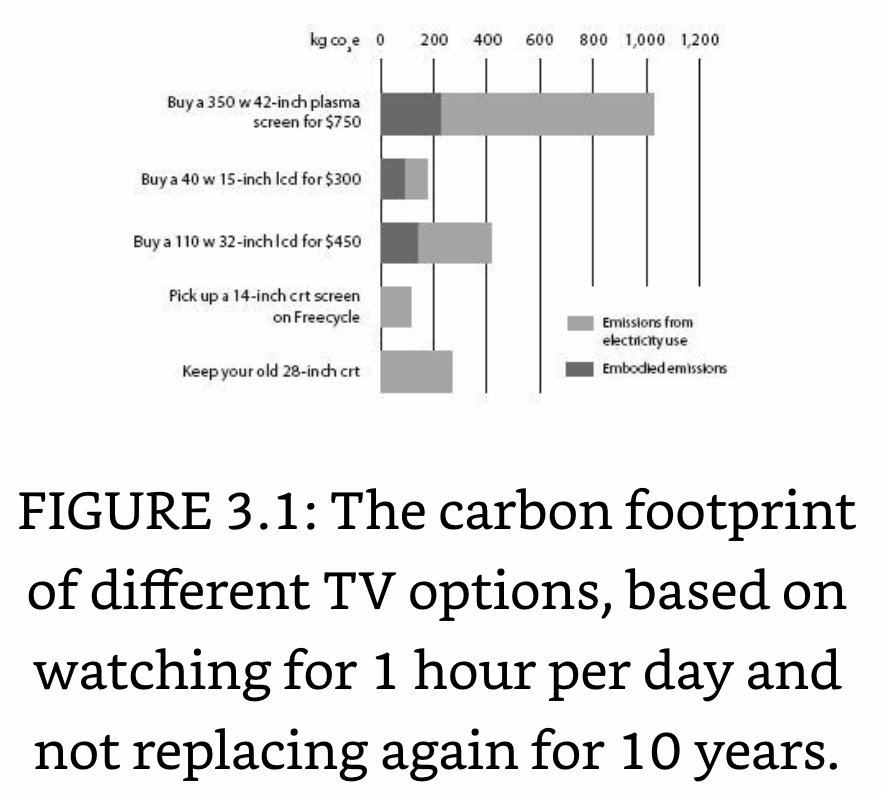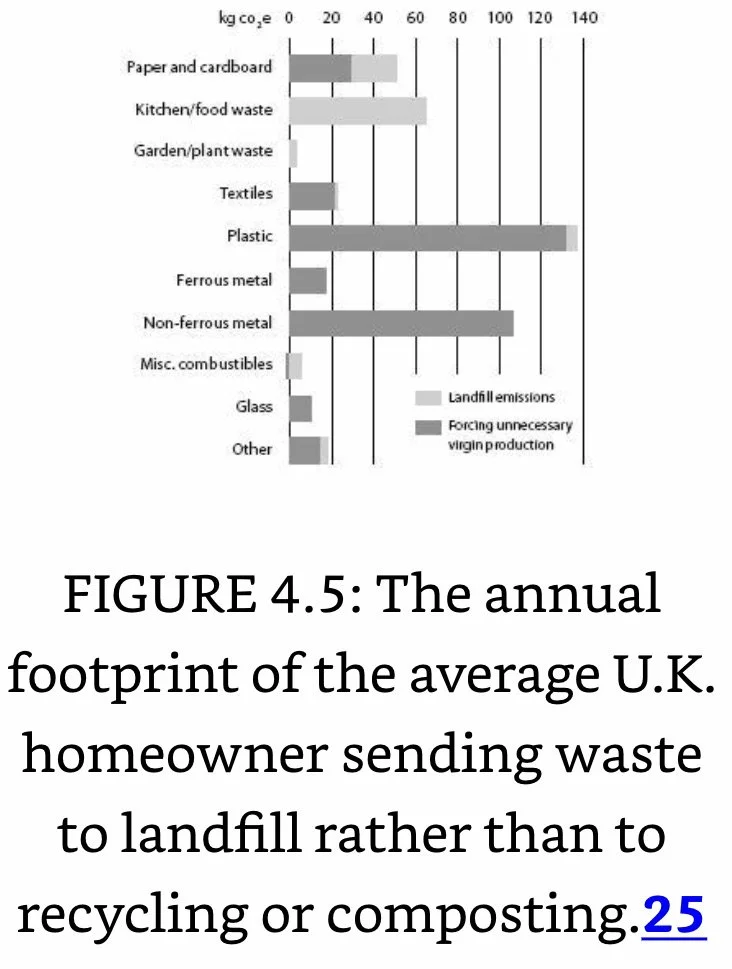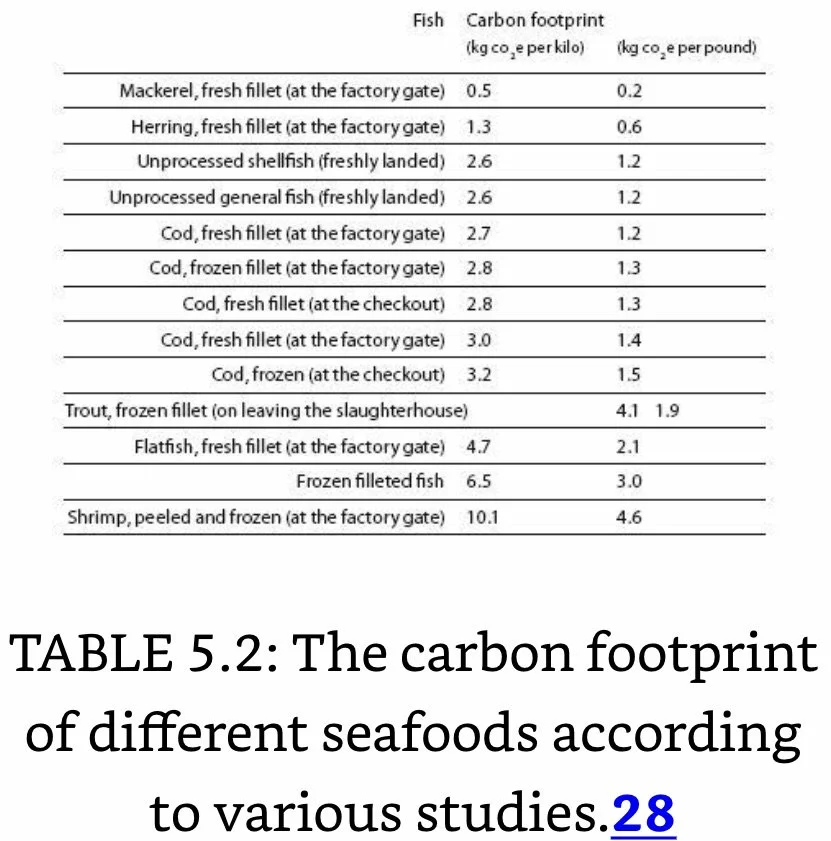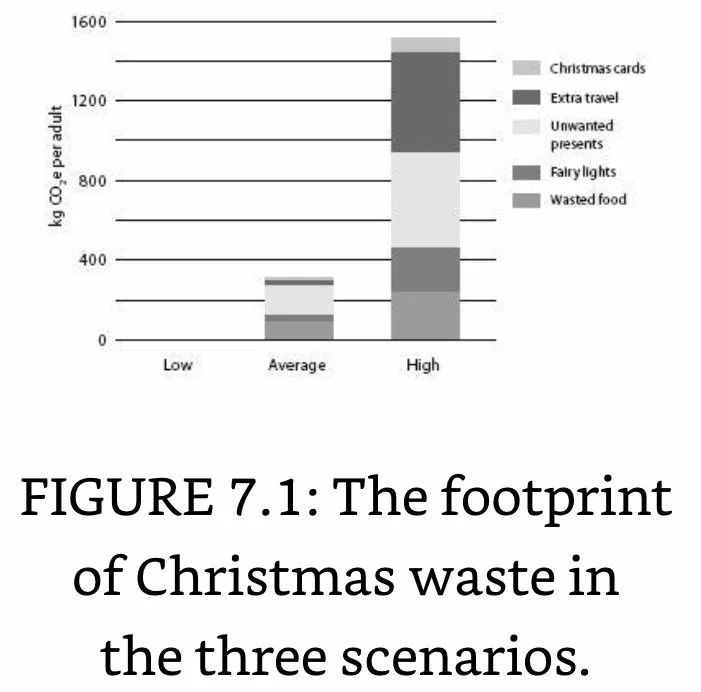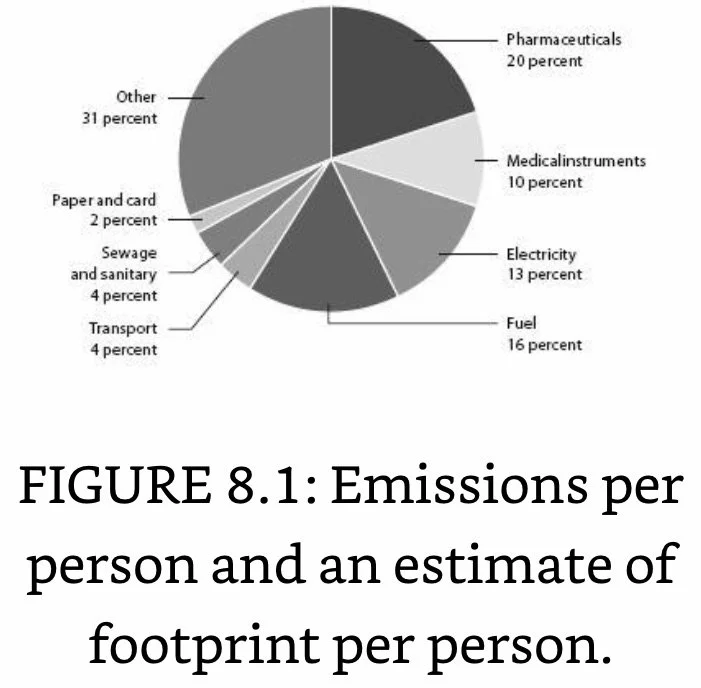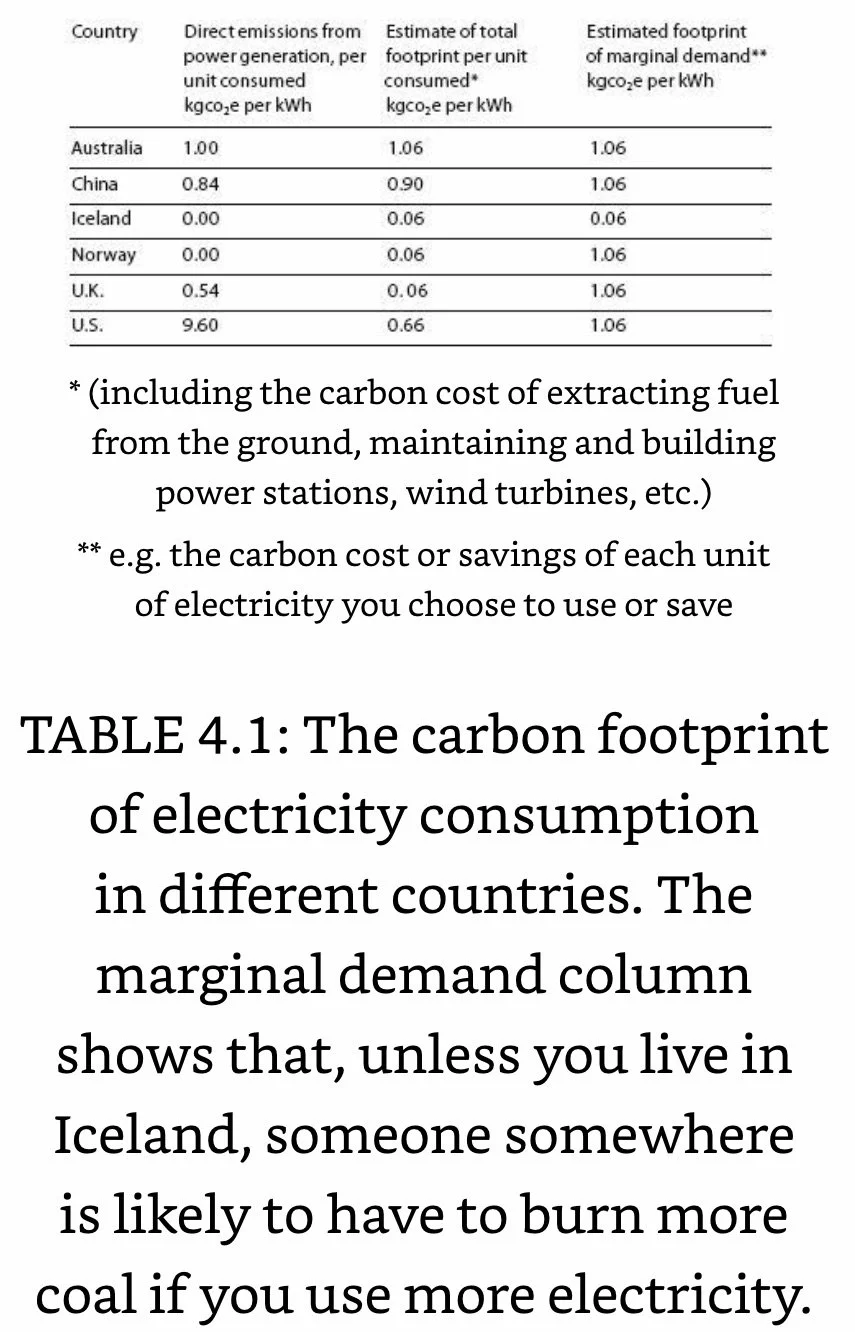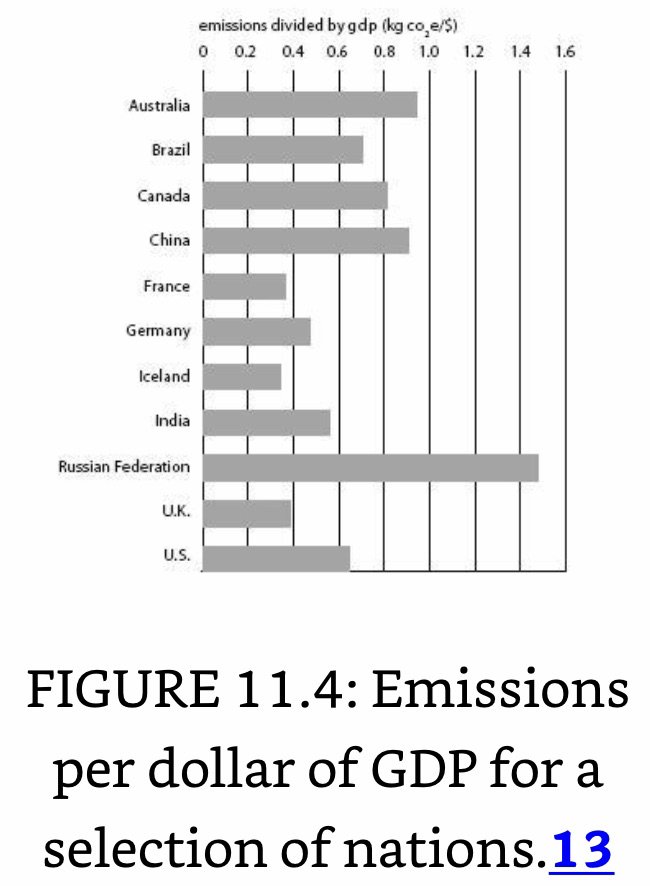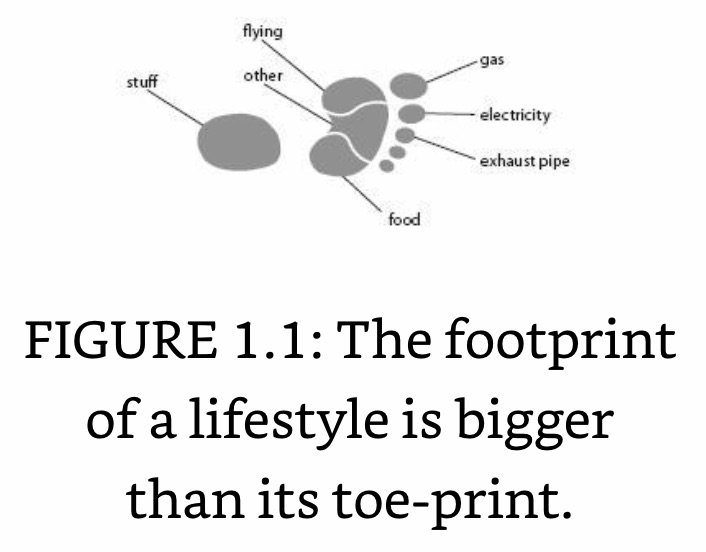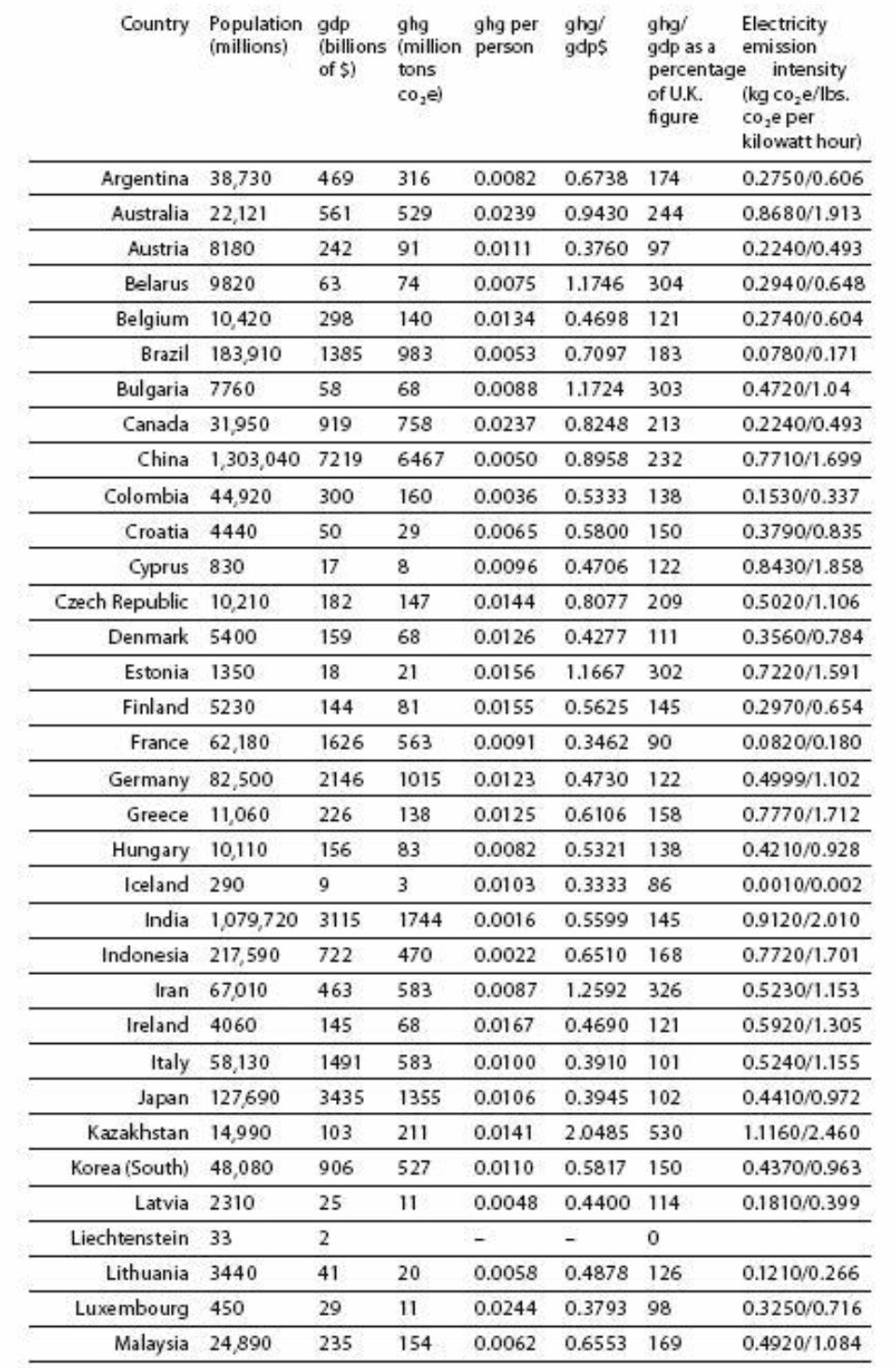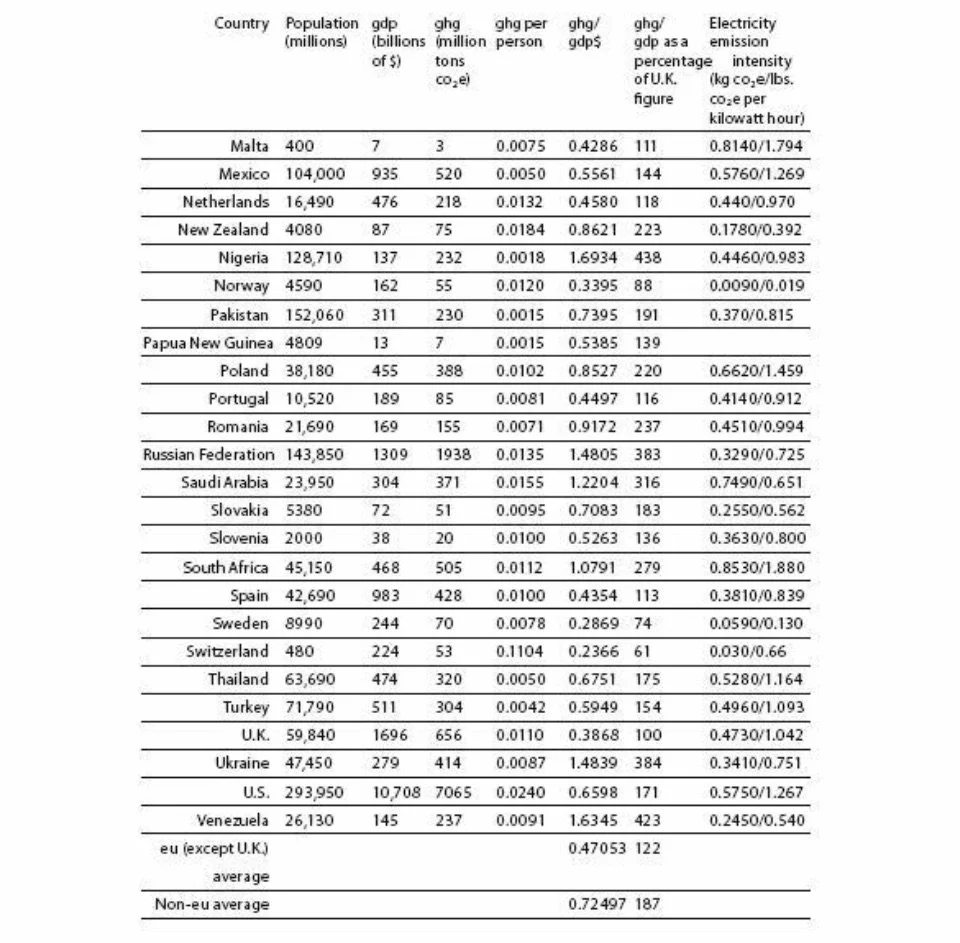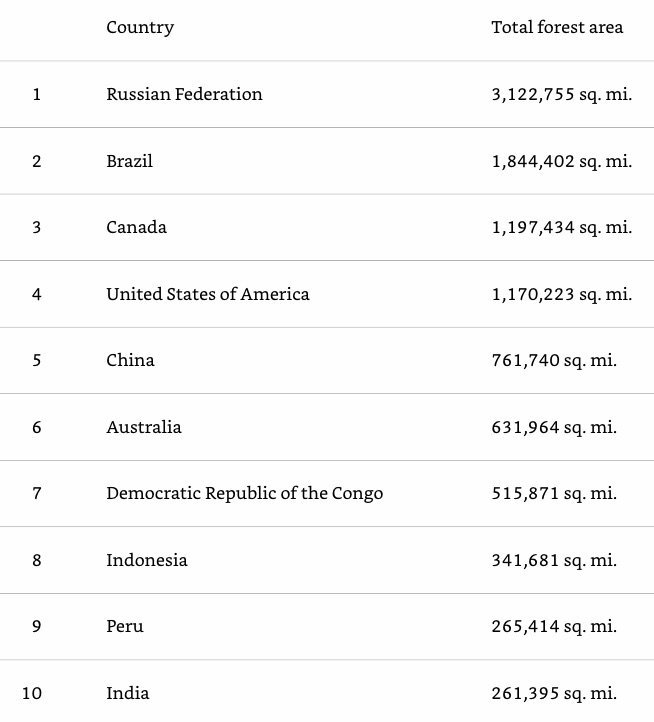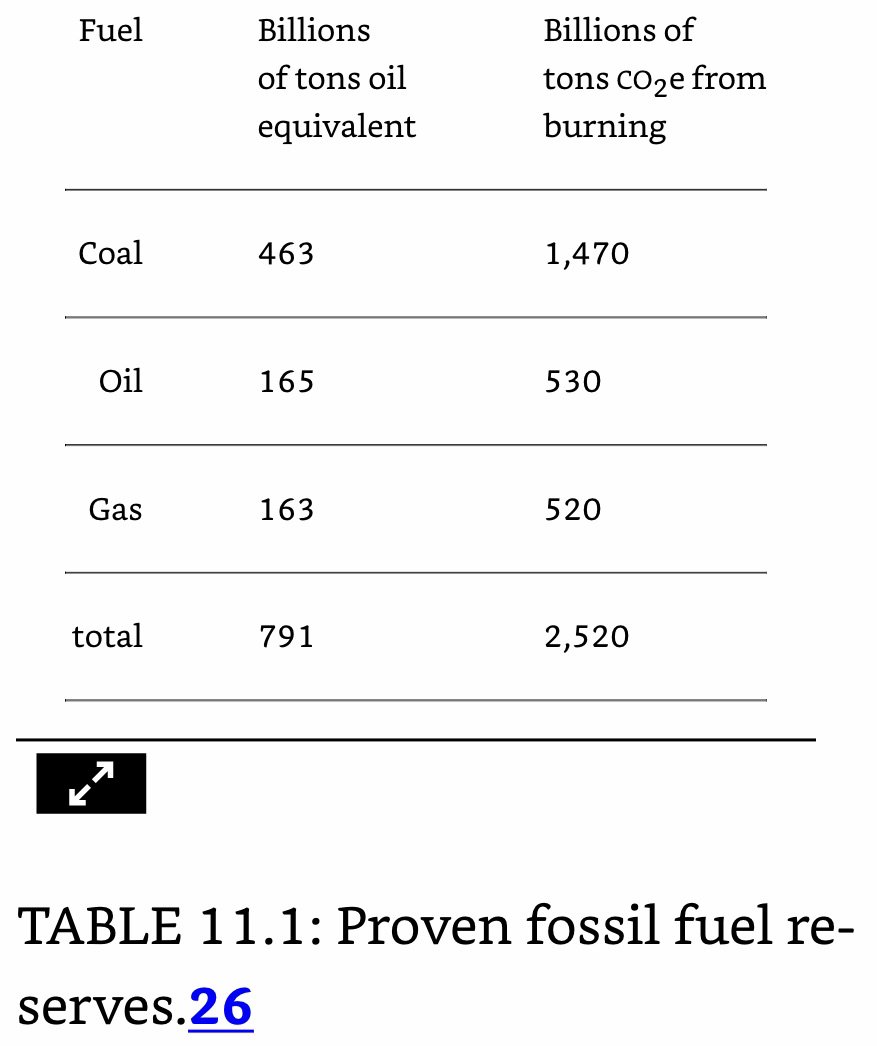How Bad are Bananas by Berners-Lee
Ref: Mike Berners-Lee (2011). How Bad are Bananas? The Carbon Footprint of Everything. Profile Books Ltd.
Contact: info@howbadarebananas.com
_______________________________________________________________________________
Summary
I started out with three assumptions:
Climate change is a big deal.
It is caused by humans.
We can do something about it.
Carbon Dioxide Equivalent (CO2e): The total climate change impact of all GHGs (∑ (CO2, CH4, N2O, Fx)) caused by an item or activity rolled into one and expressed in terms of the amount of CO2 that would have the same impact. CO2e modeling includes transport, processing, packaging refrigeration, and other operations.
When you see a number like “2.5 kg (5.5 lbs.) CO2e” on an item such as a burger, bear in mind that it is a best estimate. What it really means is something like “best estimate of 2.5 kg (5.5 lbs.) CO2e, probably between 1.5 and 4 kg (3 and 8 lbs.) CO2e and almost certainly between 1 and 10 kg (2 and 20 lbs.).” That is the nature of all C footprints.
This book isn’t about telling you what values to have, but from time to time it’s worth remembering that climate change is not the only issue. If you care about animal welfare as well as climate change, buying fewer eggs but making them organic might be a sensible compromise.
The World emits ~50B t CO2e annually.
If all your money goes into travel, you may be at the worst end of the irresponsibly wealthy. If you invest it in forests and wind farms, you are at the opposite extreme, using your wealth to bring about a low-C world.
_______________________________________________________________________________
Greenhouse Gases (GHGs)
Carbon Dioxide (CO2)
Coal, Gas, Oil (Extraction/Processing): ~45%.
Landfill: 2%
Water Treatment: 1%
Aviation: 3%
Methane (CH4): Primarily from agriculture and landfill site; 25x more potent than CO2.
Agriculture: 50%
Livestock: 5%
Rice: 1.5%
Nitrous Oxide (N2O): Primarily from industrial processes and farming; 296x more potent per weight than CO2.
N Fertilizers
Fuel Combustion
Industrial Processes
Waste Treatment
F Gases: Thousands of times more potent per weight than CO2; 1.1% of CO2e.
Refrigeration
Air-Conditioning (AC)
USA GHG Emissions Breakdown: 85%- CO2, 8%- CH4, 5%- N2O, 2%- Fx.
_______________________________________________________________________________
Foods
Apple
Plucked from your Garden: 0g CO2e.
Local/seasonal: 10g CO2e.
Average: 80g CO2e.
Shipped, cold stored: 150g CO2e.
Asparagus (250g pack)
Local/Seasonal: 125g CO2e.
Air freighted from the tropics, in season: 2.7kg CO2e.
Bacon (25g slice): 200g CO2e.
Banana
Plucked from your Garden: 0g CO2e.
Imported from Tropics: 80g CO2e.
Beef (1kg): 18kg CO2e.
About nine-tenths of this footprint comes from the beef farming itself.
N2O accounts for ~30% of the footprint; released when N-fertilizer is applied to grass and other fodder crops, and when the grass is silaged.
Beer (Pint)
Locally Brewed Cask Ale at the Pub: 300g CO2e.
Locally Bottled Beer from the Store or a Pint of imported Beer in a Pub: 500g CO2e.
Bottled Beer from the store, extensively transported: 900g CO2e.
Bread (Loaf): 1kg CO2e (~50% of emissions come from growing of the ingredients and one-sixth from the baking).
Burger
Veggie Burger: 1kg CO2e.
4oz Cheeseburger: 2.5kg CO2e.
Boiling Water (1qt)
Gas Stove-top Kettle: 50g CO2e.
Electric Kettle: 70g CO2e.
Saucepan on the gas without a lid: 115g CO2e.
Carrots (1kg)
Local, seasonal: .25kg CO2e.
Average: .3kg CO2e.
Imported Baby Carrots: 1kg CO2e.
Cheese (1 kg, hard): 12kg CO2e (It takes ~10qts of milk to make 1 kg of hard cheese).
Eggs (Carton): 3.6kg CO2e (Organic eggs are ~25% worse than those from battery farms- Cranfield U. Study).
Ice Cream (60g)
Supermarket Popsicle eaten on day of purchase: 50g CO2e.
Big Dairy Ice-cream from a van: 500g CO2e.
Lamb (1kg): 17kg CO2e
Milk (Pint): 723g CO2e.
~85% of milk’s footprint is generated on the farm.
Orange
Plucked from your Garden: 0g CO2e.
Imported from Tropics: 90g CO2e.
Air-Freighted: 1kg CO2e.
Of the 300 types in existence, almost oranges we eat are of the cloned “Cavendish” variety.
Porridge (Bowl)
Traditional with Oats/Water: 82g CO2e.
With Half Milk: 300g CO2e.
Milky and Sweet: 550g CO2e.
Potatoes (1kg boiled)
Local, boiled gently with lid on: 620g CO2e.
Local, boiled furiously with lid off: 1.17kg CO2e.
Rice (1kg): Globally, ~600M t CO2e of CH4 is emitted from rice paddies (~1.2% of total GHGs).
Efficiently produced: 2.5 kg CO2e.
Average: 4 kg CO2e.
Inefficiently produced with excessive use of N- fertilizer: 6.1 kg CO2e.
Rice has a high C footprint due to CH4 that bubbles out of of flooded paddy fields and excessive N-fertilizers.
Strawberries (Basket)
Grown in Season locally: 150 g CO2e.
Non-seasonal, imported by air: 1.8 kg CO2e.
Tea/Coffee
A Mug with nothing added: 23g CO2e.
With Milk: 55g CO2e.
With Milk boiling extra water: 74g CO2e.
Large Cappuccino: 236g CO2e.
Large Latte: 343g CO2e.
A single latte every day would be nearly 1% of the 10t lifestyle.
Tomatoes (1kg)
Organic, local: .4kg CO2e.
Average: 9.1kg CO2e.
Organic on the vine cherry tomatoes, imported, out of season: 50kg CO2e (the highest C-food in this book).
Trout (1kg)
Canned: 5.9kg CO2e.
Fresh from the store of frozen: 6.9kg CO2e.
Water
Cup of Tap Water: .06g CO2e.
Bottle of Water (.5L): ~1000x more C Intensive than tap.
Locally sourced using local distribution: 110g CO2e.
Average: 160g CO2e.
Traveled 1000km by road: 215g CO2e.
Cup of Tap Water poured down the drain: .25g CO2e.
It is more C intensive to treat waste water than to supply the water in the first place.
Wine (Bottle)
Local: 400g CO2e.
Average: 1.04kg CO2e.
Over-elaborate bottles, imported thousands of km by road: 1.5kg CO2e.
Three bottles per week is about 150 kg per year.
The glass bottle accounts for a similar amount of C to that of the wine it contains. Therefore, buying boxes or cartons will reduce the footprint of the packaging by a factor of ~5.
_______________________________________________________________________________
Animals
Animals are inefficient devices for producing food. They eat plants and then spend their lives wasting most of the energy from them on things such as walking around and keeping warm. It is a far more efficient process for humans to eat plants directly, so that all the plant energy can go directly to us.
Ruminants (Beef, Lamb) are doubly high in C because of belching. Chickens are relatively better than ruminants due to their decreased lifespan.
If the C footprint were the only consideration, the unpleasant truth is that the most efficient thing to do would be to keep cattle in small indoor spaces and rear them as intensively as possible, minimizing wasteful activities such as getting exercise or keeping warm.
One partial solution to the belching problem, legal in the U.S. since 2004 and widely used, is Rumensin, a simple additive that markedly cuts CH4 production in cows. The EU classified it as an antibiotic and banned it, despite research that indicates otherwise.
The market for soy is driving deforestation, of which most is fed to cows.
_______________________________________________________________________________
Travel & Transport
Air
Flying (R/T LAX- BCN):
Economy: 3.4t CO2e.
Average: 4.6t CO2e.
First Class: 13.5t CO2e.
3x Economy trips are a whole year’s worth of 10t living.
A Boeing 747 carrying 416 pax burns through 116t of fuel on the 9,700 km flight each way. ~1/3 of the total weight on take-off is fuel. As the fuel burns, it creates 3x its weight in CO2. The impact is worse still because high-altitude emissions are known to have a considerably greater impact than their low-altitude equivalents.
In this book I have multiplied all aviation emissions by 1.9 (some experts believe the true impact is even higher and suggest a multiplier of up to 4.)
Boat (Cargo Ship)
When produce is being moved, 1.5km by air has >100x the climate impact of 1.5km by sea.
Bus (1.5km with 20 pax): 150g CO2e.
Car
~50% of emissions from car travel come from the exhaust pipe. A few percent come from the processes of extracting, shipping, refining, and distributing the fuel, the rest, ~40% of the footprint, is associated with manufacture and maintenance. Cars make up ~15% of the global total.
Buying a Car: ~480kg CO2e per $1000 value.
New smart car: 6t CO2e.
Ford Taurus: 17t CO2e.
Land Rover: 35t CO2e.
Commuting, Congested (20km): 22kg CO2e (average US Car at 22.4mpg).
Driving (1.5km)
Fiat 500 at 100kph: 350g CO2e.
Average US Car (22.4mpg): 850g CO2e.
SUV (150 kph): 2.5kg CO2e.
Air resistance (and fuel consumption) increases with the square of the speed.
Roadtrips
SUV (1500km): 800kg CO2e.
The best gas cars tun only about 25% of its fuel energy into motion, with the rest dissipated as heat. Diesel engines are typically about 30% more efficient at turning fuel energy into vehicle movement.
Gasoline (1qt): 3.15kg CO2e.
Cycling (1.5km)
1.5 km cycling powered by bananas: 65g CO2e.
1.5km cycling powered by cereals with milk: 90 g CO2e.
1.5km cycling powered by bacon: 260 g CO2e.
1.5km cycling powered by cheeseburgers: 260 g CO2e.
Hotel Night
Low C, Eco Hotel: 3kg CO2e.
Bed and Bkfst with Dinner and Drinks: 24kg CO2e.
High C, Luxury Hotel: 60kg CO2e.
Train (1.5 km)
Intercity Standard Class: 150g CO2e.
London Underground: 160g CO2e.
Light Rail/Tram: 190g CO2e.
Intercity first class: 300g CO2e.
Comparing Transportation Modes (700km trip)
SUV: 1100kg CO2e.
Train: 120kg CO2e.
Small Efficient Car: 330kg CO2e.
Plane (sitting in coach): 500kg CO2e.
_______________________________________________________________________________
Energy & Electronics
Cell Phone: 16kg CO2e for manufacture.
Using a cell (1yr)
Cell use of 2min/day: 47kg CO2e.
Cell use of 1h/day: 1250kg CO2e.
Computer
Computer Manufacture
Simple low cost laptop: 200kg CO2e.
2010 21.5” iMac: 720kg CO2e.
All the frills desktop: 800kg CO2e.
Using a computer (per hour)
Energy efficient laptop: 13g CO2e
2010 21.5” iMac: 69g CO2e.
Old Desktop: 165g CO2e.
Servers and networks: 55g CO2e.
Drying your Hands
Dyson Airblade: 3g CO2e.
Paper towel: 10g CO2e.
Standard Electric Drier: 20g CO2e.
E-Reader Manufacture: ~50kg CO2e.
Electricity (unit): One of the principal causes of C-emissions globally; >50% of energy is lost at the power station or in the transmission grid. Domestic Energy use accounts for ~22% of total GHGs annually (13% Household fuels, 9% electricity).
From the Icelandic Grid: 60g CO2e.
From the Canadian Grid: 220g CO2e.
From the UK Grid: 600g CO2e.
From the US Grid: 660g CO2e.
From the Chinese Grid: 900g CO2e.
From the Australian Grid: 1kg CO2e.
Domestic energy (22% of total CO2e)
Email
Spam Email: .3g CO2e (~62T spam messages are sent annually requiring 33B units of electricity and emitting ~20M t CO2e per year).
Proper Email: 4g CO2e.
Email with attachment: 50g CO2e.
Google Search (Google uses ~.2g CO2e worth of energy per search, the rest is your computer).
Efficient laptop: .9g CO2e
Desktop: 4.7g CO2e
Heat Unit (1 KWh)
Solar water heating panel: 50g CO2e.
Modern (90% efficient) gas furnace: 244g CO2e.
Old Gas Furnace (55% efficient): 400 g CO2e.
Using the US e- grid: 660g CO2e.
Using the Australian e- grid: 1kg CO2e.
Lights (left on for 1yr)
Low Energy Bulbs: 90 kg CO2e.
100W Incandescent: 500 kg CO2e.
Turning a light on does not use the same energy as leaving it on for half an hour.
Solar (Photovoltaic) panels
Production for a roof capable of generating 1800 KWh/yr: 3.5t CO2e (.47 kg CO2e per $1 spent).
Lifetime Energy Savings: 50t CO2e (-1.8t CO2e per year).
TV
Watching (1hr): Americans average 4h TV per day, Europeans 3.5h, Canadians 3h.
15” LCD Flat Screen: 37g CO2e.
28” CRT TV: 84g CO2e.
32” LCD Flat Screen: 97g CO2e.
42” Plasma: 240g CO2e.
Manufacture
$750 Brand New TV: 240kg CO2e
Wind Turbine (15KW with 9m Diam): At the biggest end of the micro-renewable’s spectrum.
Production: 30t CO2e.
20y savings: 500t CO2e.
Cost: ~$61.5K to purchase + $14.5K to install.
Output: 25K KWh if placed in the right spot.
World Data Centers (2010): 130M t CO2e (expected to rise to 250-340M t CO2e in 2050). According to IT advisory company Gartner, the world’s data centers currently account for one-quarter of the energy consumed around the world by the information and communication technology sector.
_______________________________________________________________________________
Financial
Spending $1 on/at…
A well-executed rainforest preservation project: -220kg CO2e.
Solar Panels: -2kgCO2e.
Financial/Legal/Professional Advice: 105g CO2e.
A Car: 480g CO2e.
Supermarket: 620g CO2e.
A flight: 3.1kg CO2e.
Gasoline: 6.5kg CO2e.
Electricity Bill: 4kg CO2e.
Budget Flights: 10kg CO2e.
_______________________________________________________________________________
Packaging & Construction
Glass: Energy intensive to make and to recycle. Its weight adds to the transportation footprint.
Cement (100g)
Standard Cement: 710g CO2e.
Global Average: 910g CO2e.
Inefficiently produced Standard Cement: 1kg CO2e.
The world produces ~2.2B t of cement per year (~47% is produced in China); ~4% of global total GHGs.
The Chemical process that turns limestone into cement gives off large volumes of CO2 directly and takes a huge amount of energy. ~40% comes from the burning of fuel to drive the chemical reaction, leaving 10% for other bits and bobs in the cement industry and its supply chains.
Paper
Paper Bags
Recyclable, Lightweight: 12g CO2e.
Heavy (used by many clothing retailers): 80g CO2e.
Burying (landfill) 1kg of Paper: 500g CO2e.
Paper Production (1 kg): The C footprint of depends on recycled content, paper quality, and mill efficiency.
Pure Virgin: 2.59kg CO2e.
100% Recycled Paper: 1.3kg CO2e.
Most junk mail ends up in landfill, where it decomposes anaerobically and produces CH4.
Paper and cardboard are often more carbon intensive than plastic packaging, mainly because making paper is so energy intensive but also because it emits methane if it ends up in landfill.
It takes ~2x as much energy to make paper from trees as it does from recycled pulp.
Plastic
Lightweight plastic bag: 3g CO2e.
Standard Disposable Supermarket bag: 10g CO2e.
Reusable, Heavyweight plastic bag: 50g CO2e.
PET (kg): 3.3kg CO2e.
Plastics inability to rot is good news in as much as it won’t add to CH4 emissions from landfill.
Biodegradable plastic packaging is a well-intentioned disaster area. It sounds great, but if you send it to landfill, it rots down and emits methane, and if you throw it into the recycling, it can ruin the entire batch.
_______________________________________________________________________________
Clothes & Fabrics
Cotton (kg): 7kg CO2e.
Diapers: The average child stays in diapers for ~2.5y and is changed ~4x/day (~3650 diapers).
Reusable, line-dried, washed at 60°C: 89g CO2e.
Reusable, tumble dried, washed at 90°C: 145g CO2e.
There is usually no C advantage to be had from reusable diapers. If you wash them very hot and tumble-dry them, reusables can be the worst option of all.
Ironing: ~400g CO2e/hr.
Quick ironing a shirt: 14g CO2e.
Average Shirt Ironing: 25g CO2e.
Ironing a thoroughly crumpled shirt: 70g CO2e.
Laundry (5kg): If you wash and dry a load every two days, that’s equivalent to 440 kg per year.
Washed at 30°C & Air Dried: .6kg CO2e.
Washed at 40°C & Air Dried: .7kg CO2e.
Washed at 40°C & Tumble Dried: 2.4kg CO2e.
Washed at 60°C & Dried in a Dryer: 3.3kg CO2e.
For a typical 40°C wash, ~75% of the C-footprint comes from drying. Tumble driers generally use electricity to generate heat (>2x more than generating heat from gas). If you use a conventional vented drier, most of the heat is simply pumped out to the outside world, so overall it’s a wasteful activity.
Nylon (kg): 7-9kg CO2e.
Pants
Nylon: 3kg CO2e.
Cotton Jeans: 6kg CO2e.
Shoes: ~50% of the CO2e is due to the materials, 25%- energy manufacture, 15%- transport, 5% box, 5%- other.
Crocs: 1.5kg CO2e.
Synthetic: 8kg CO2e.
Average: 11.5kg CO2e.
All leather: 15kg CO2e.
_______________________________________________________________________________
Water
Bath
Water heated by Solar: 0g CO2e.
Modestly filled warmed with an efficient gas heater: .5kg CO2e.
Generously filled warmed with an efficient gas heater: 1.1kg CO2e.
Generously filled warmed with electric water heater: 2.9kg CO2e.
Dishwashing
Cold water by hand: ~0g CO2e.
Lukewarm, sparring use of water: 540g CO2e.
Dishwasher, 55°C: 770g CO2e (2x per week equates to ~80kg CO2e per year).
Dishwasher, 65°C: 990g CO2e.
Hot water by hand, excessive water use: 8kg CO2e.
The results of the great dishwasher versus handwashing debate are as follows. The most careful hot-water handwashing just about beats the dishwasher but loses out badly on hygiene (~400x the bacteria count on the dishes) and time (4x as long as loading the dishwasher). Overall, the dishwasher wins, particularly because the figures here don’t reflect the most energy-efficient machines that are now on the market.
Shower
3min, efficient gas furnace, aerated showerhead: 90g CO2e.
6min, typical electrically powered shower: 550g CO2e.
15min, 11KW, high volume, electrically powered shower: 1.9kg CO2e.
Desalinization (1m3): The world desalinates ~60B liters daily (.6% of the global annual footprint). In CA, Desal accounts for ~13% of CA’s e- usage and 31% of its gas consumption.
Using solar power: 0g CO2e.
Average reverse osmosis plant using e: 5kg CO2e.
Inefficient thermal desal plant: 23kg CO2e.
_______________________________________________________________________________
Homelife
Book Manufacture
Recycled Paper: 400g CO2e.
Average: 1kg CO2e.
Thick Virgin Paper with half the copies unsold: 2kg CO2e.
Carpet
Thin 4m x 4m Polyurethane carpet with thin underlay: 76kg CO2e.
Thick 4m x 4m wool, polypropylene, or nylon with generous underlay: 290kg CO2e.
Cremation: 80kg CO2e.
Home
New: ~80t CO2e.
Refurbishment: 8t CO2e.
Insulating an Attic (3BR Home): 350kg CO2e with ~35 t CO2e payback over 40 years.
Red Rose (x1)
Picked from your Garden with no inorganic fertilizer used: 0g CO2e.
Grown in Columbia and flown by air: 350g CO2e.
Grown in a heated Greenhouse and then flow by air: 2.5kg CO2e.
Trash: 400kg CO2e annually (the Average American sends 570kg to landfill and recycles 290kg annually).
Garden Waste (200g): 1kg CO2e.
Average Trash Contents: 700g CO2e.
Toilet Paper Roll: ~75kg CO2e per year for typical N. Americans.
Recycled paper: 450g CO2e.
Virgin Paper: 730g CO2e.
Necklace: ~265g CO2e per dollar spent on jewelry.
Handed down or made from driftwood and seashells: 0g CO2e.
$750 new Welsh gold: 200kg CO2e.
$750 worth of gold and diamonds from developing nations: 400kg CO2e.
_______________________________________________________________________________
Agriculture
Fertilizer (1t): A significant contributor to the worlds C footprint. When fertilizer is applied, ~1-5% of the N it contains is released as N2O, which is around 300x more potent than CO2, adding between 1.7-8.3t CO2e to the total footprint.
N- fertilizer efficiently made and sparingly spread: 2.7t CO2e.
N- fertilizer inefficiently made and used in excess: 12.3t CO2e.
All plants contain nitrogen, so if you’re growing a crop, it has to be replaced into the soil somehow or it will eventually run out. Nitrogen fertilizer is one way of doing this. Manure is another. Up to a point there can be big benefits. For some crops in some situations, the amount of produce can even be proportional to the amount of nitrogen that is used. However, there is a cut-off point after which applying more does nothing at all to the yield, or even decreases it. Timing matters, too. It is inefficient to apply fertilizer before a seed has had a chance to develop into a rapidly growing plant.
One-third of all N- fertilizer is applied to fields in China—about 26M t per year. The Chinese government believes there is scope for a 30-60% reduction without any decrease in yields. In other words, emissions savings on the order of 100M t are possible just by cutting out stuff that does nothing whatsoever to help the yield.
Agricultural Emissions: ~53% N2O, 36% CH4, 11% CO2.
_______________________________________________________________________________
Humanity
A person per year
Average Malawian: .1t CO2e.
Average Chinese: 3.3t CO2e.
World Average: 7t CO2e.
Average UK: 15t CO2e.
Average N. American: 28t CO2e.
Average Australian: 30t CO2e.
Countries per year (2005)
Malawi: 1.5M t CO2e.
Iceland: 4M t CO2e.
Australia: 610M t CO2e.
France: 810M t CO2e.
UK: 862M t CO2e.
Canada: 890M t CO2e.
Brazil: 980M t CO2e.
Germany: 1.35B t CO2e.
India: 1.4B t CO2e.
Russian Federation: 1.94B t CO2e.
China: 4.3B t CO2e.
USA: 8.25B t CO2e.
_______________________________________________________________________________
Catastrophic Events
Black Carbon: 7-15B t CO2e per year.
Outdoor Fires (purposeful and accidental): 42%.
Burning of wood, coal, dung, peat, and other organic stuff in homes: 25%.
Transport (mainly Diesel): 25%.
Coal-fired power stations: 10%.
Burning the world’s fossil fuel reserves: 2.5T t CO2e
Deforestation (1 hA): 500t CO2e (9B t CO2e worldwide annually; ~18% of total emissions)
Globally we are cutting down or burning about 32M acres of rainforest per. ~70% (22M acres) involves clearing forest to make way for livestock and other agriculture. One estimate is that 20-25% of rainforest loss is due to cattle grazing, 35-45% to small holdings, 15-20% to intensive agriculture, 10-15% to logging, and perhaps 5% to other causes such as urbanization, mining, roads, and other infrastructure.
Forest Fire
2009 Australian Forest Fires burning 450K hA with trees storing 100 t CO2/acre: 165M t CO2e.
2008 CA Summer Forest Fires: 231M t CO2e.
Space Shuttle Flight: 4600t CO2e.
Swimming Pool, Public: 400t CO2e per year.
University: 72K t CO2e per year.
Volcanoes: ~300M t CO2e per year.
Mount Etna: 1M t CO2e.
Mount Pinatubo (1991): 42M t CO2e.
Eyjafjallajökull (2010) daily: 150K t CO2e.
Volcanic CO2e emissions data is misleading because, alongside their warming effect, emissions also cause a cooling effect due to ash and SO2 entering the atmosphere and reflecting sunlight away from Earth.
_______________________________________________________________________________
Terminology
Amazon Fund: Pays farmers to not cut down their trees.
Black carbon: A component of soot caused by incomplete combustion; a potent climate-forcing aerosol and may be the world’s second-leading cause of global warming after CO2. Black-C warms the world in two ways; in the atmosphere it contributes to the greenhouse effect and on the ground it turns snow and ice murky, decreasing albedo and absorbing more of the Sun’s heat. It is thought to be a major contributor to the global reduction in ice cover, especially in the Northern Hemisphere. Black C lasts only a few days in the atmosphere.
Carbon Efficiency (aka Carbon Intensity): A nation’s footprint relative to economic activity.
Data Centers: Buildings packed top to bottom with computers, storing web pages, databases, applications, and downloads and generally make the Information Age possible. They use lots of electricity (both for powering the machines they contain and for keeping them cool with AC.
Environmental Input-Output Analysis (aka Top-Down): Looks at the whole economy and macroeconomic modeling to understand the way in which the activities of one industry trigger activities and emissions in every other industry.
Hectare: 100m x 100m (2.5 acres)
Process Based Life Cycle Analysis (aka Bottom up): Assessing a product at every phase of life cycle development and summing the various costs.
Rebound Effect: The idea that when something becomes cheaper and more efficient to do, we end up simply doing more of it so that there is no net reduction in cost or impact.
_______________________________________________________________________________
Take Action
Buy an aerated showerhead.
Insulate your attic.
Buy Boxed instead of glass wine
Use of Rumensin to reduce CH4 emissions.
Use Eco-Sheet and Eco- Cement made with Magnesite.
Call “1-800-5 OPT OUT” to stop mail generated from the three major credit reporting agencies; this will stop the majority of credit card offers.
Eat what you buy.
Save the leftovers.
Reduce meat and dairy (particularly cheese).
Buy local and seasonal produce.
Avoid excessive packaging.
Recycle your packaging.
Buy misshapen fruit and vegetables.
Use a pan lid when cooking.
Black out the bar code and address on all junk mail that is delivered using first class postage. Put a circle around the postage and write “Not accepted: return to sender.” This can be put in any mail box, and it will be returned to the business that sent it.
_______________________________________________________________________________
Misc Quotes
The standard of integrity that is demanded of the climate change believers is on a different plane altogether from that demanded of the skeptics.
1g= 15 drops of water, 30g= 1oz.
The biggest challenge is not having the ideas but putting them into action.
Optimum Population Trust estimates that 40% of all pregnancies worldwide are unintended and that offering family planning in developing countries saves carbon at a rate of $6 per ton.
Unless you will ever contemplate lighting a forest fire, the decision to reproduce is probably the biggest C choice you will ever make.
_______________________________________________________________________________
Chronology
2010: Volcanic Eruption of Eyjafjallajökull in Iceland.-Bananas by Lee.
2009: Australian Forest Fires burn 450K hA.-Bananas by Lee.
2008: CA Summer Forest Fires.-Bananas by Lee.
2004: Rumensin is legalized for use in the USA, markedly cutting methane production in cows.-Bananas by Lee.
1991: Saddam Hussein deliberately sets fire to Kuwaiti Oil Fields during the First Gulf War.-Bananas by Lee.
1910-1911: The Lakeview Gusher Oil spill in California.-Bananas by Lee.
_______________________________________________________________________________
